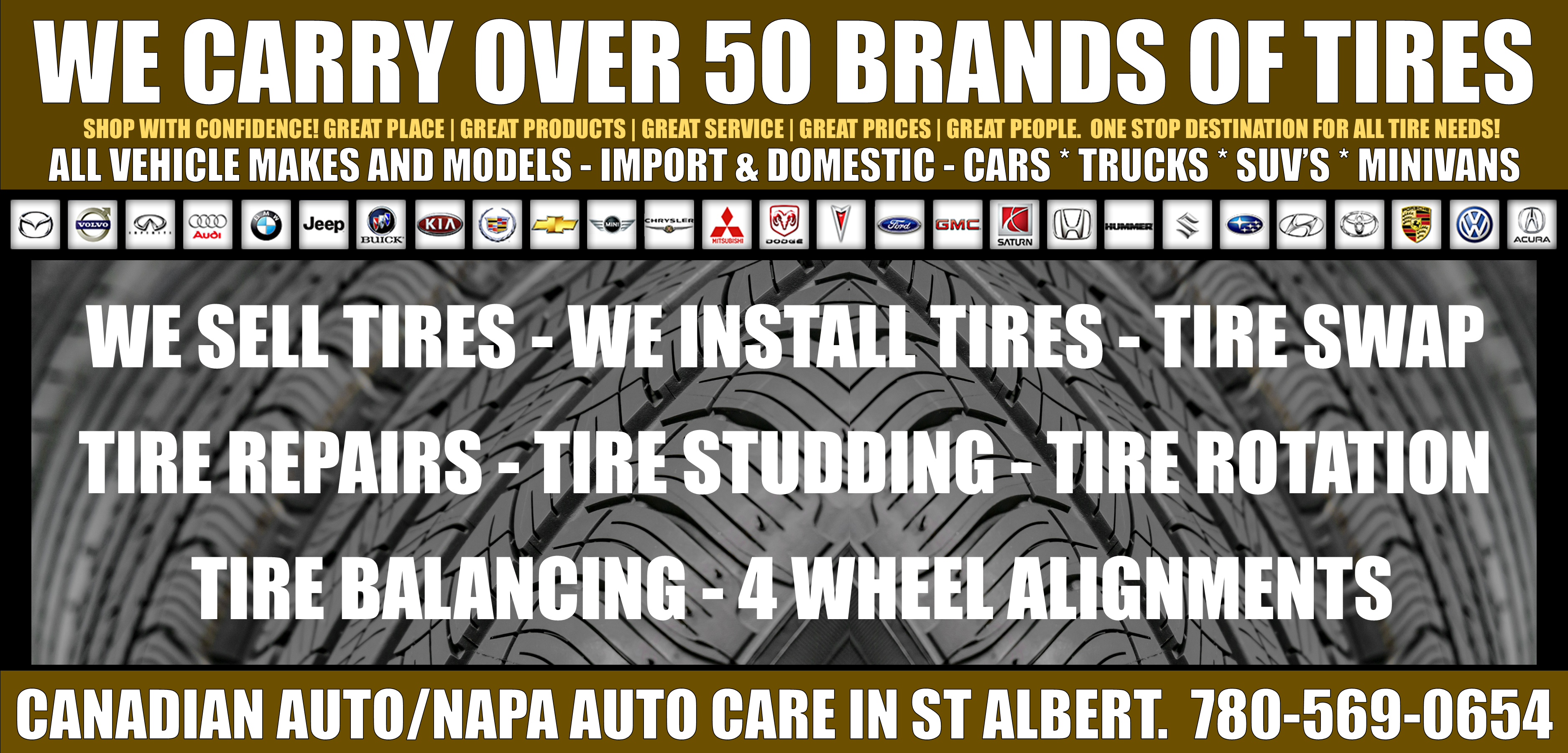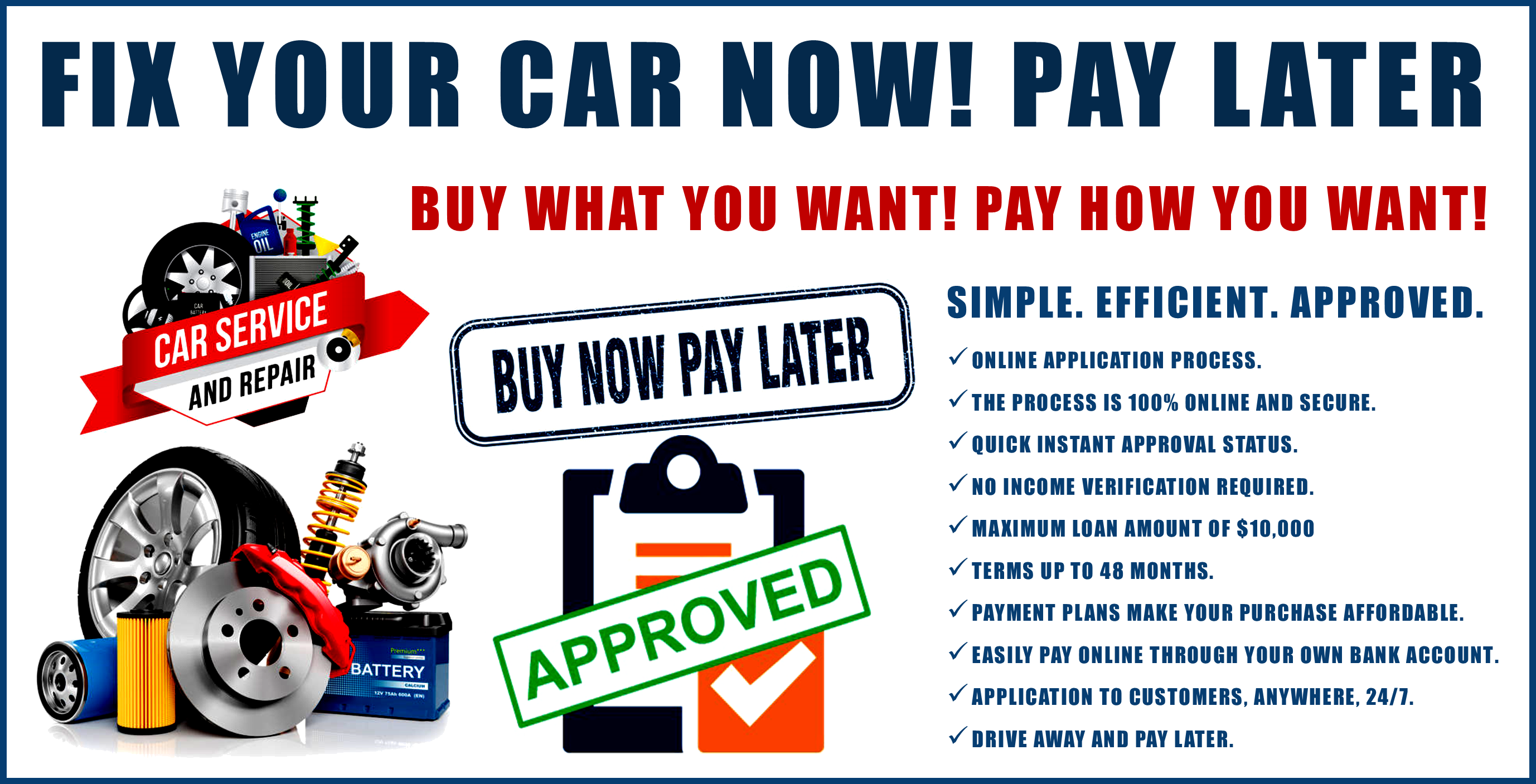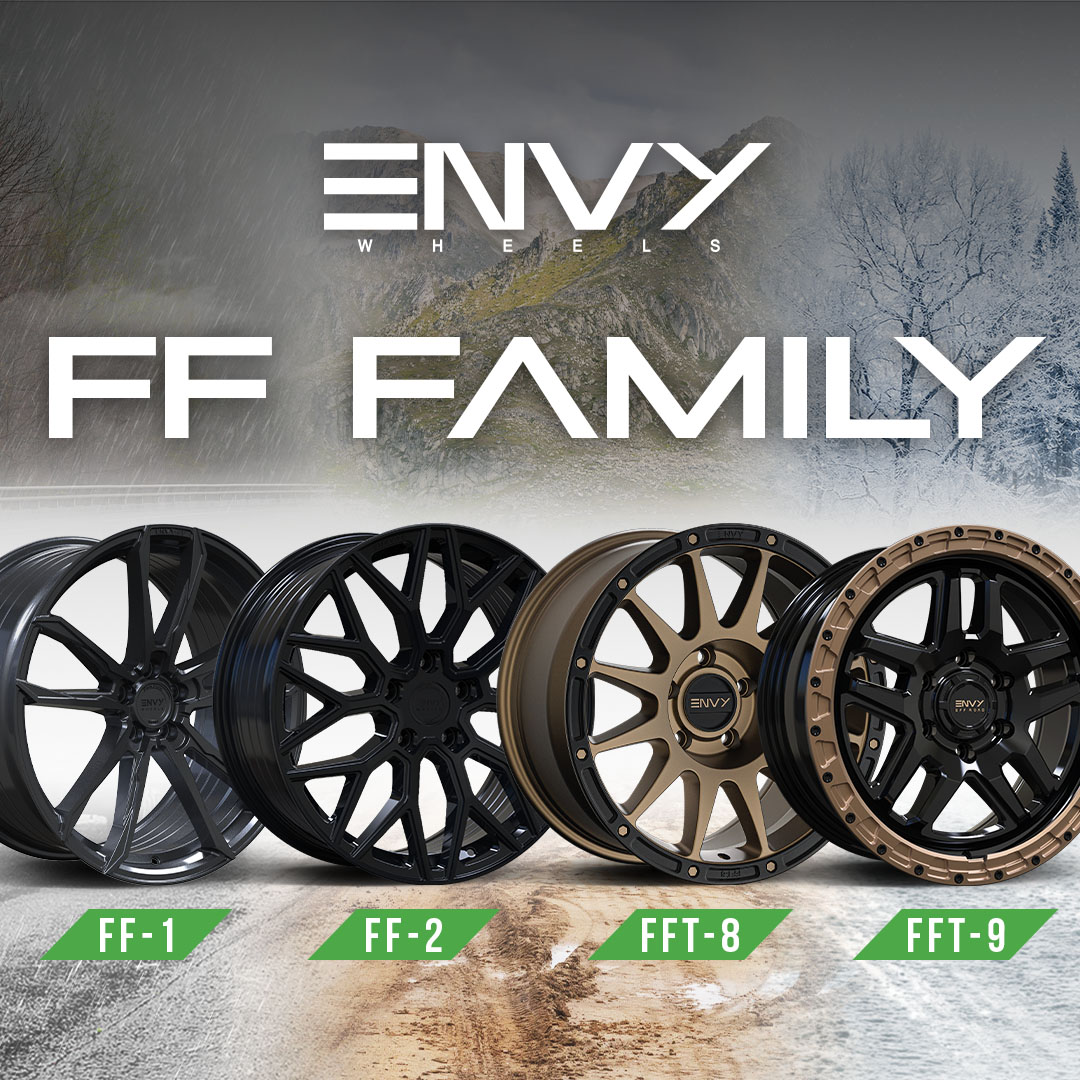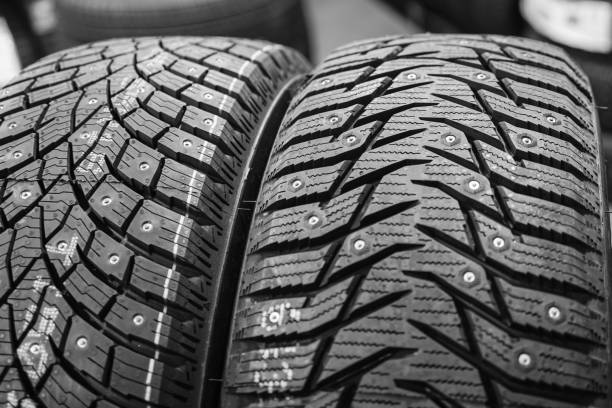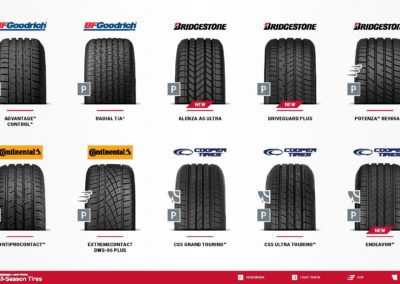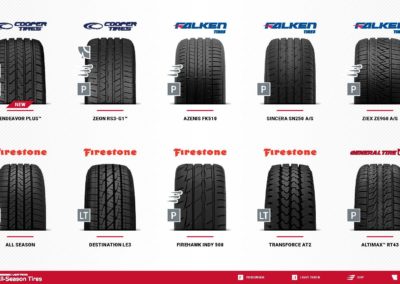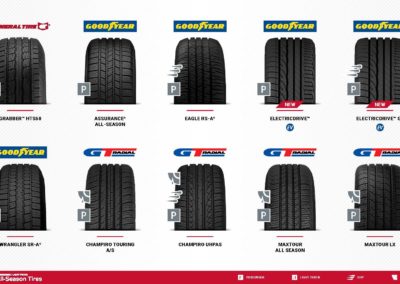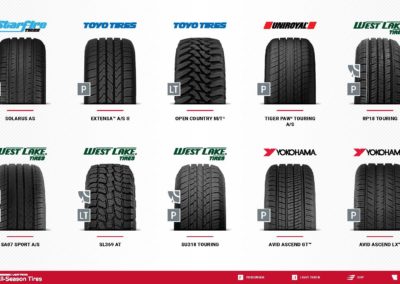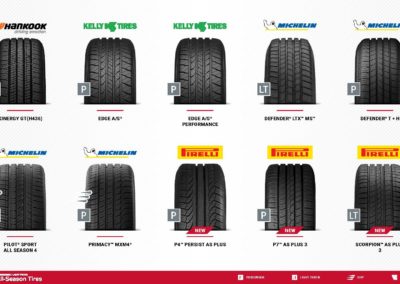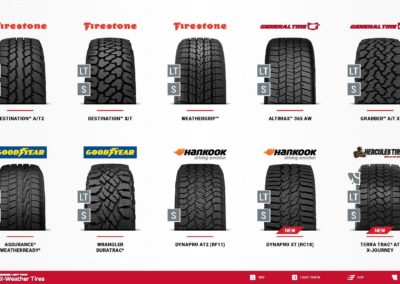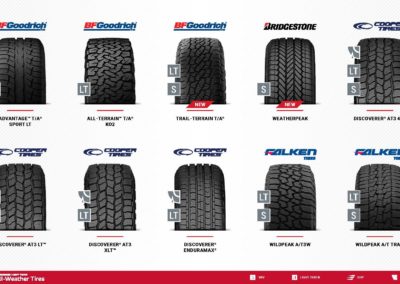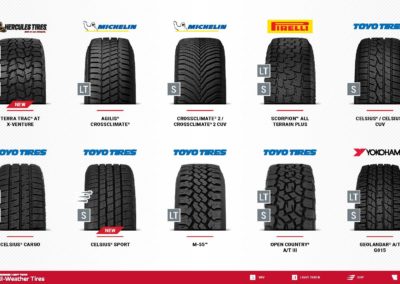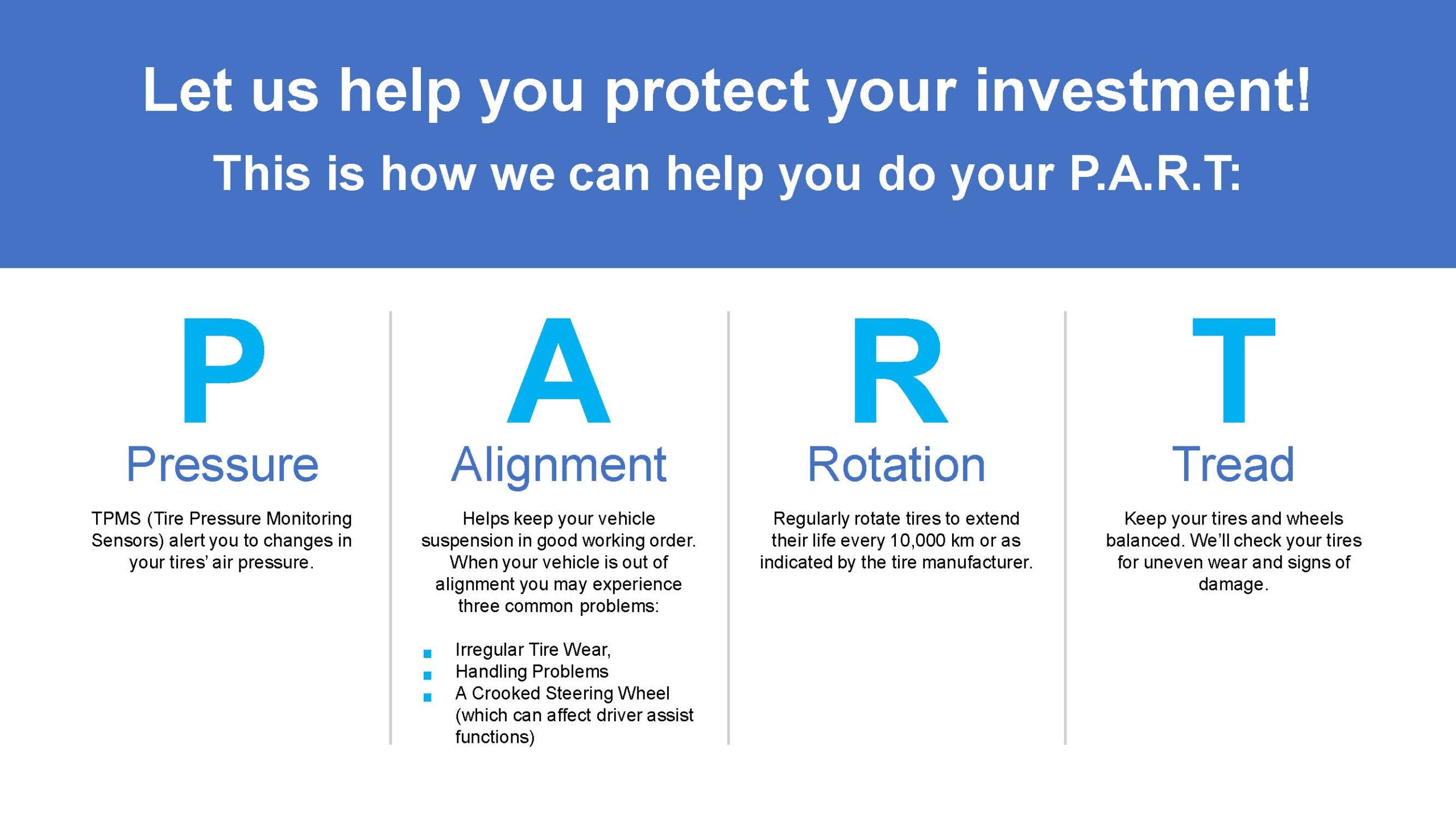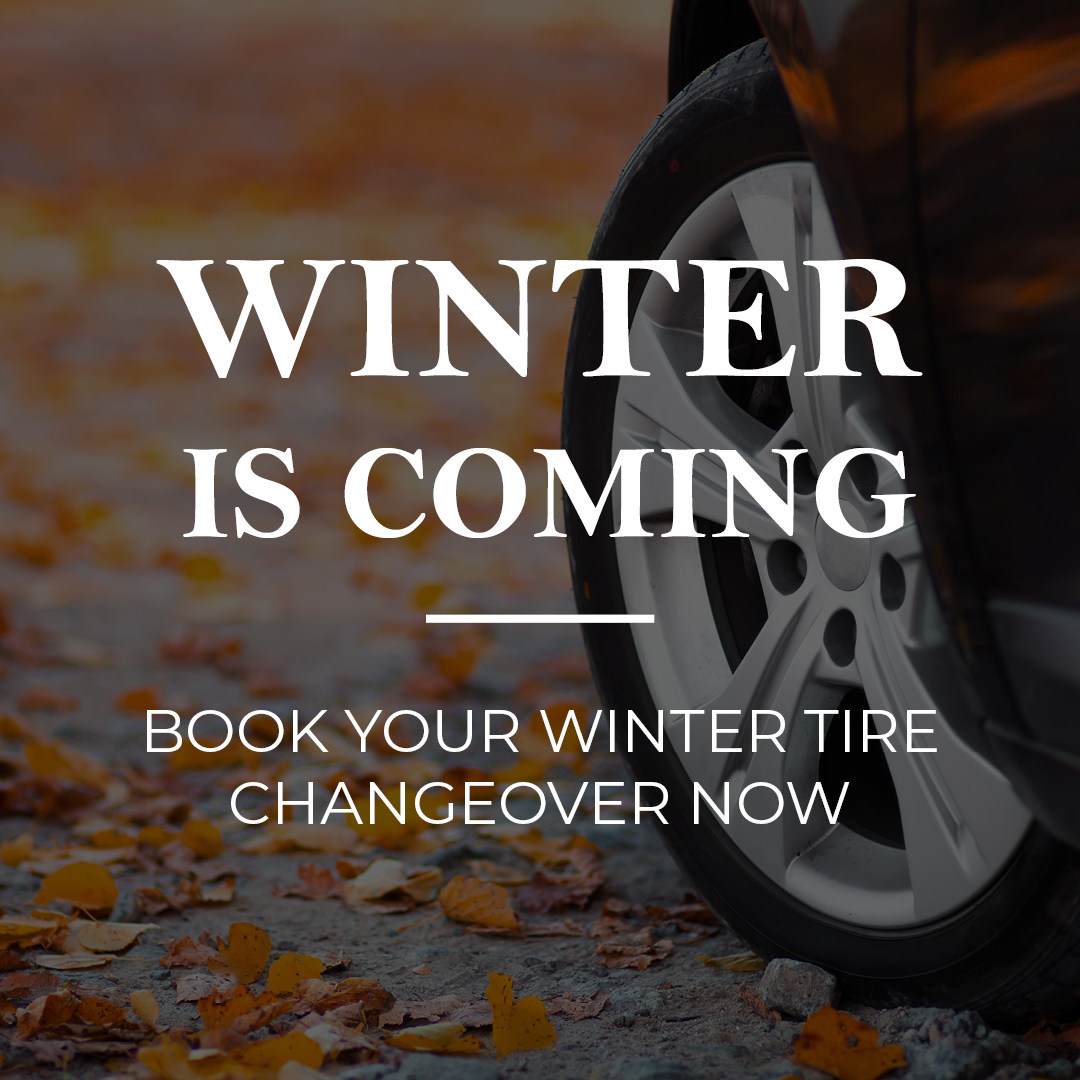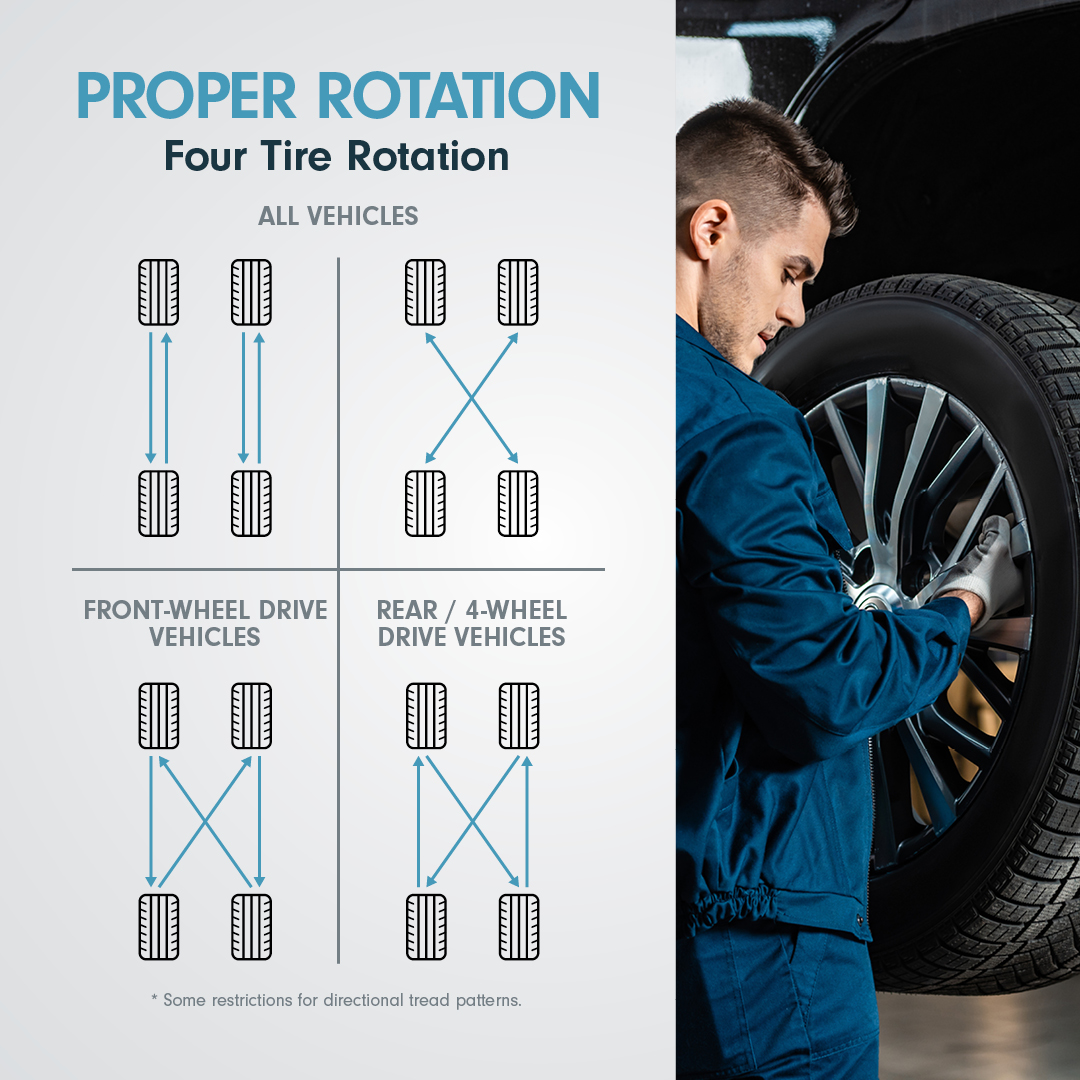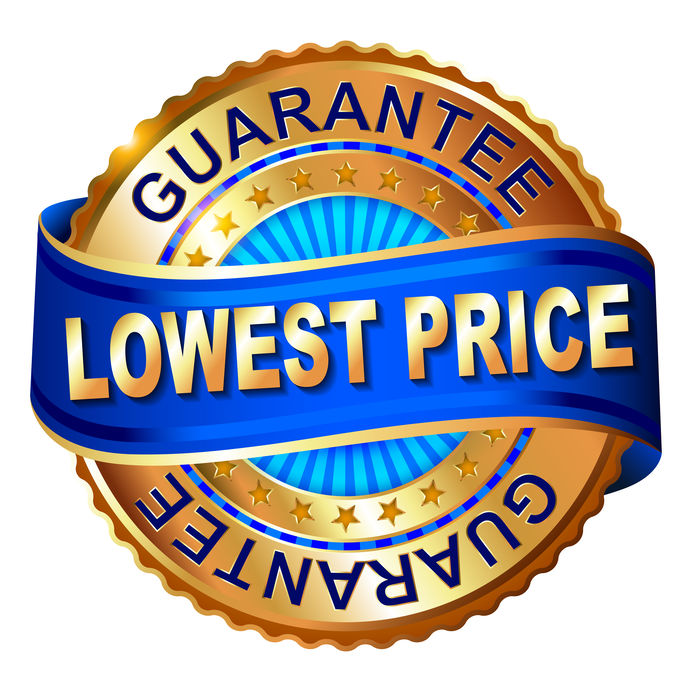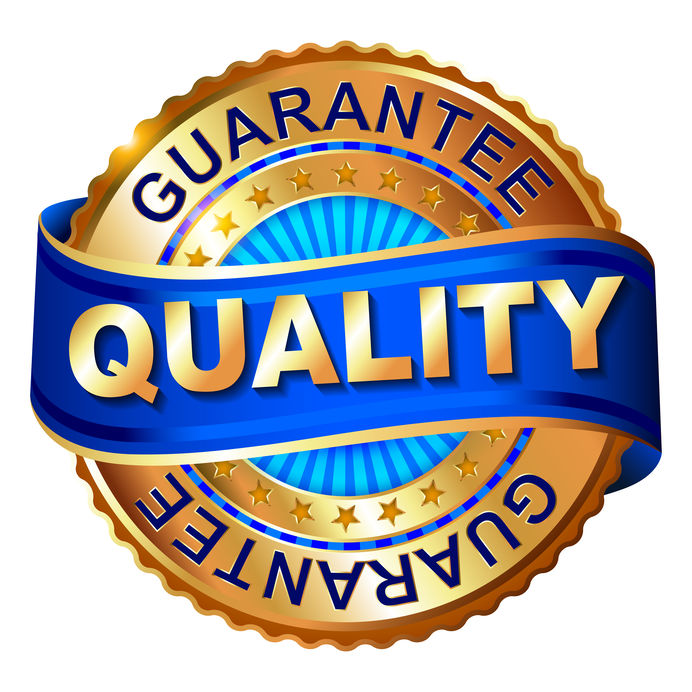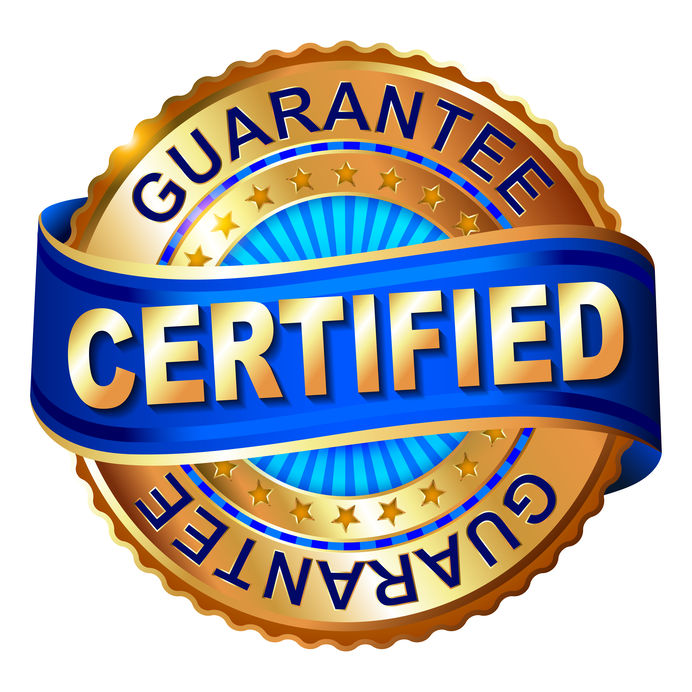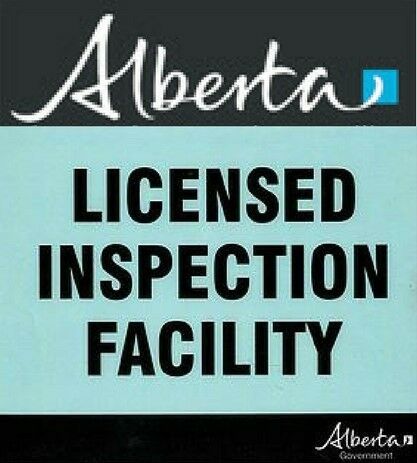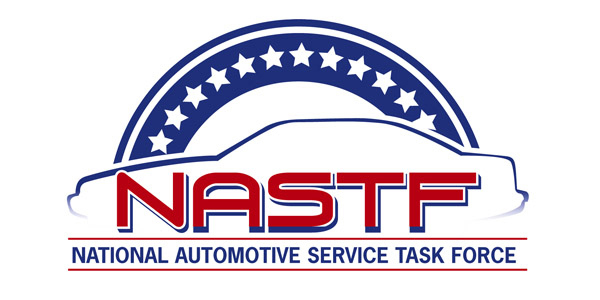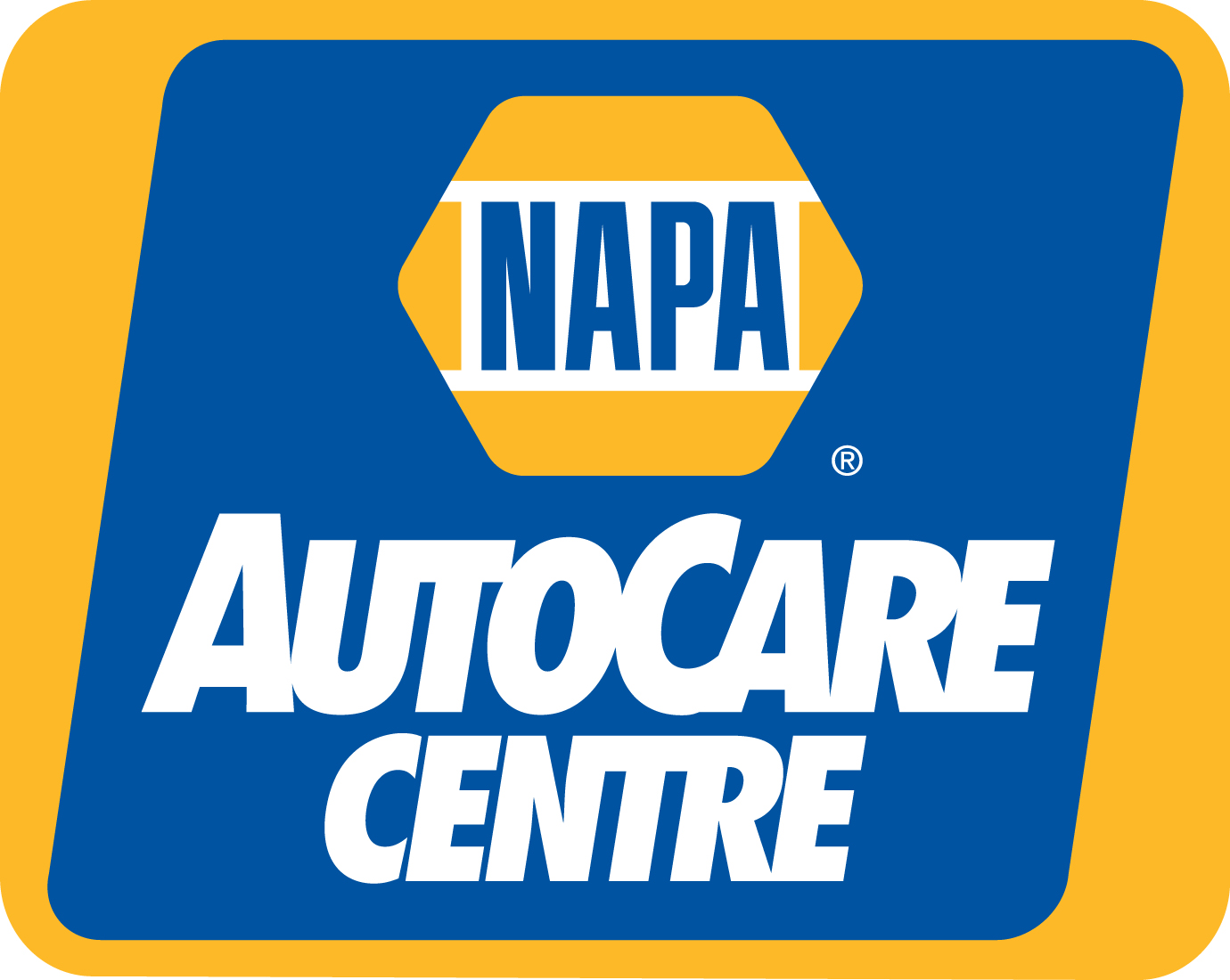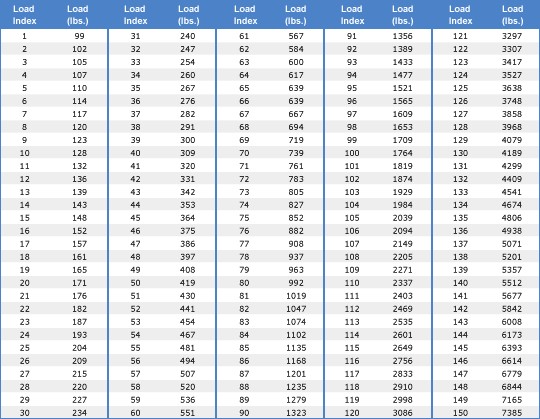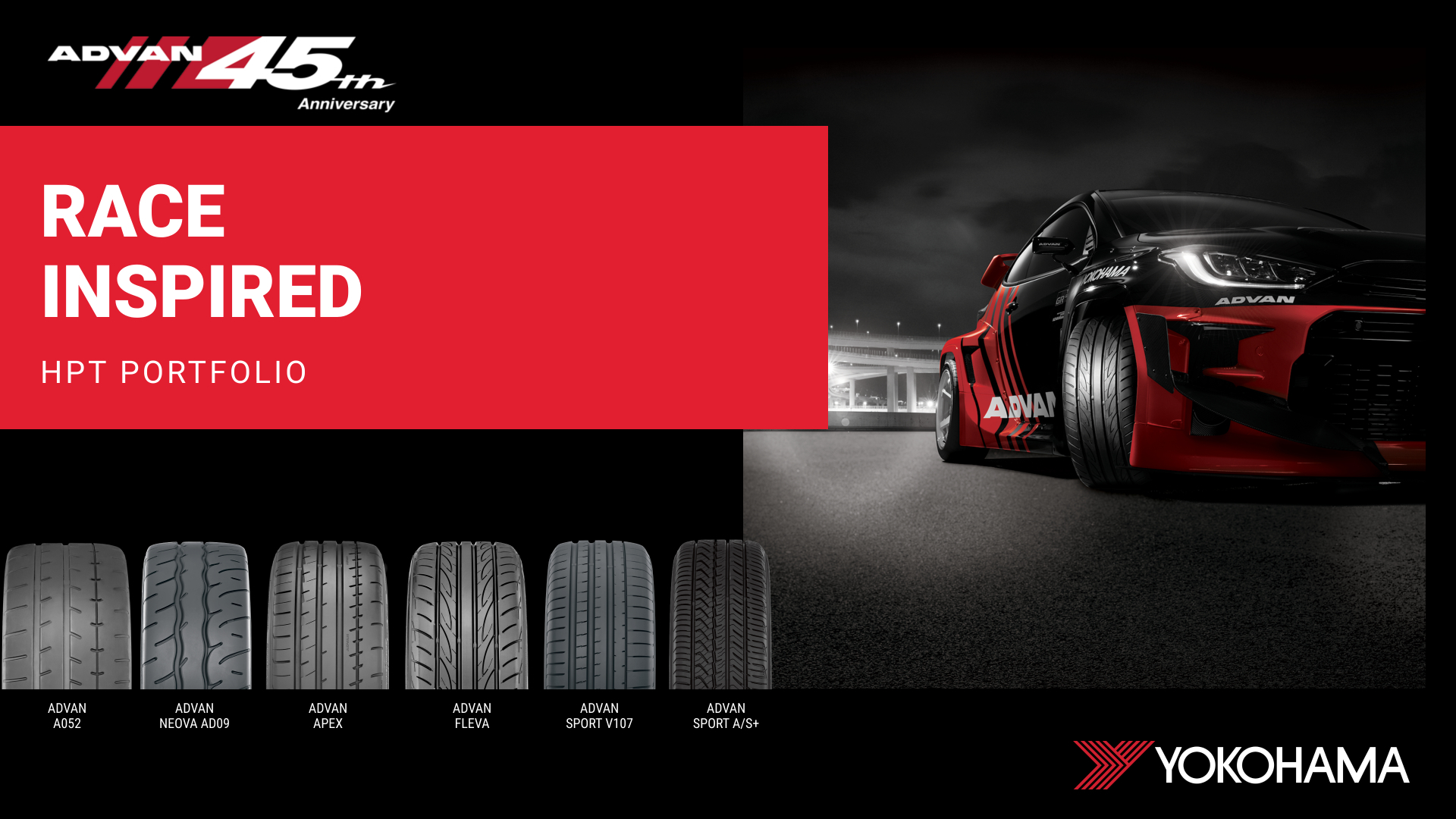
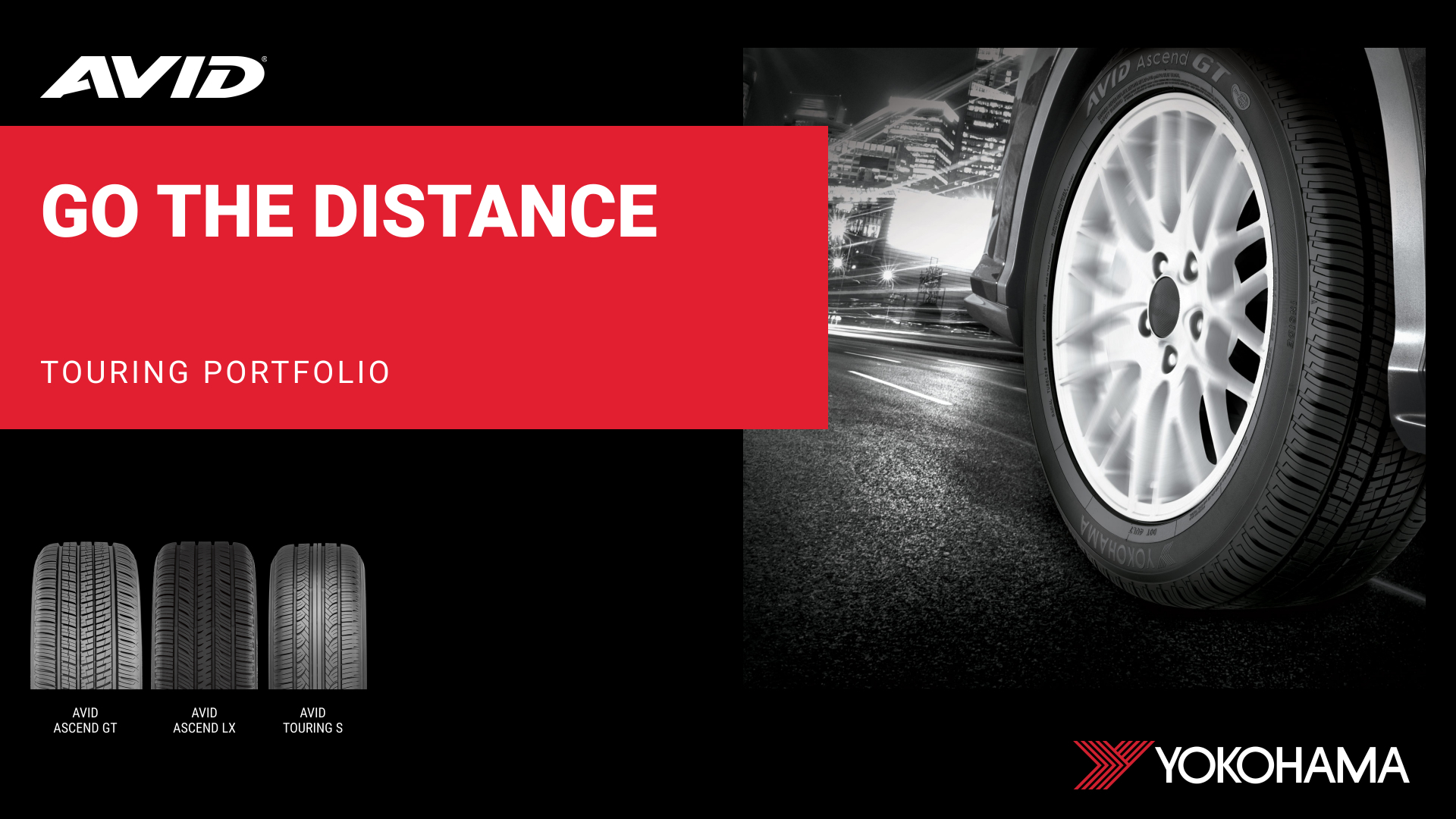
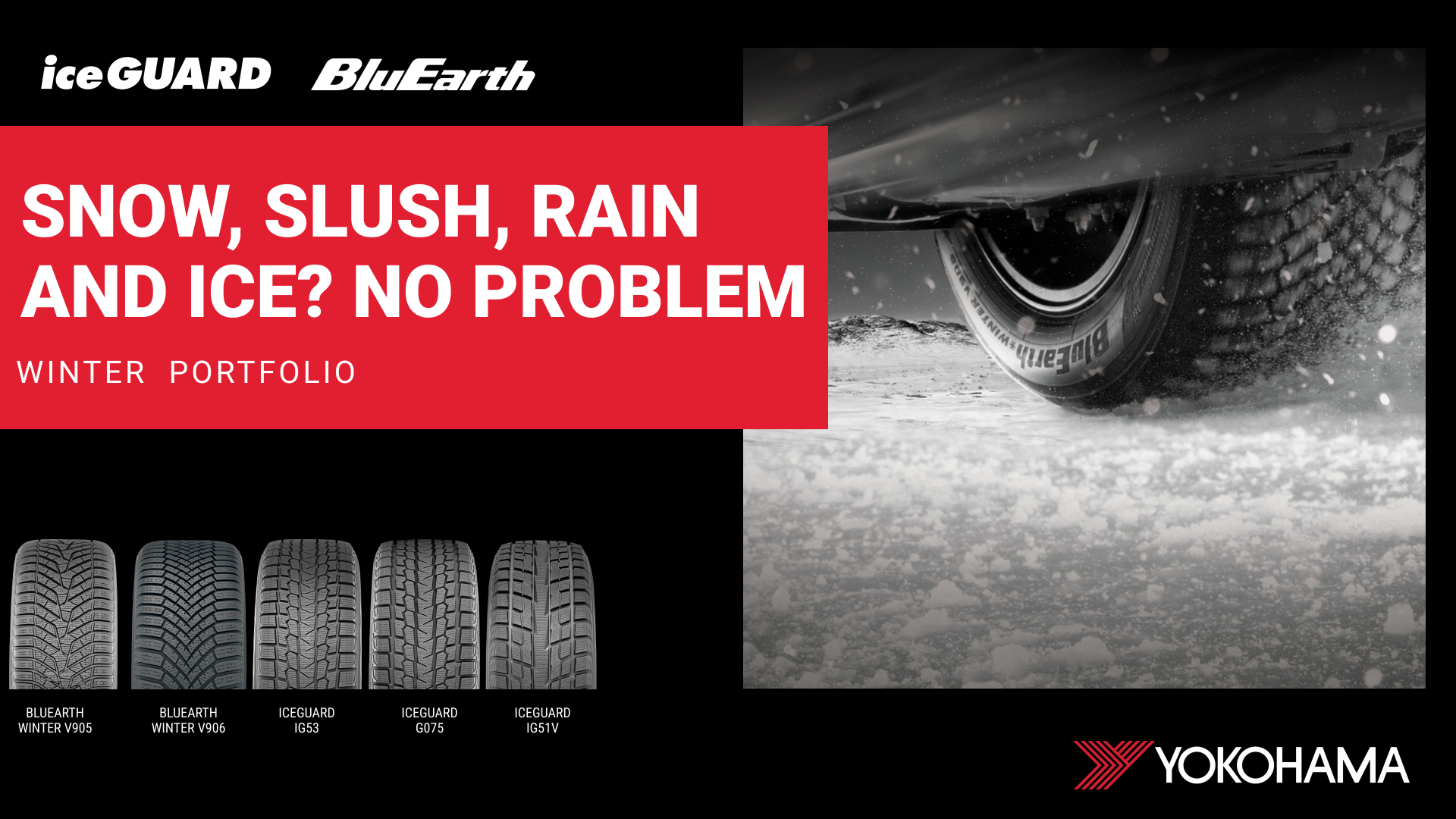
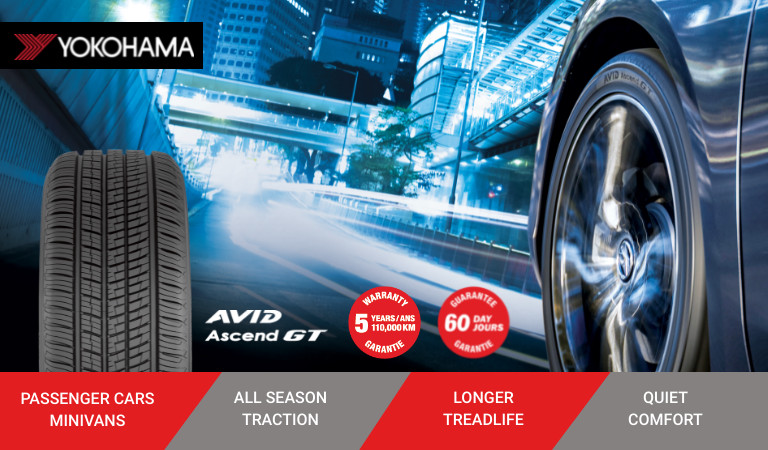
Tires & Wheels – Summer Tires – Winter Tires – All Weather Tires
Canadian auto remarketing list of tire brands that we carry; BFGoodrich, Bridgestone, Carlisle, Continental, Cooper, Dunlop, Falken, Firestone, General Tire, Gislaved, Goodyear, GT Radial, Hankook, Hercules, Ironman, Kelly Tires, Kumho, Laufenn, Maxtrek, Michelin, Nexen, Pirelli, Samson, Techking, Titan, Toyo, Uniroyal, Westlake, Yokohama, Pirelli, Toyo, Kleber, Rakla, Kenda, Dick Cepek, Fierce, Fuzion, GT Radial, Starfire, Mickey Thompson, General tire, Nitto, Dayton, Nankang, Sumitomo Tire. At Canadian Auto/Napa Auto Care Centre in St Albert we can keep our overhead costs low in order to be able you to provide your better tire prices.
Fix Your Auto Repairs/Buy Tires/Get an Extended Warranty Now, Pay Later!
Are you a bit short on cash now and need to fix your vehicle? Keep your cash and use the vehicle’s value to pay for maintenance and repair costs! We can help! Auto repairs can be costly when they happen. Whether it is unforeseen mechanical issues, or a new set of tires. Canadian Auto/Napa Auto Care offers Automotive Repair Financing with our flexible auto repair loans will get your vehicle safely back on the road – quickly. Canadian Auto/Napa Auto Care, fix your auto repairs/buy tires/buy an extended warranty Now, Pay later!
When the engine light comes on, your main concern should not be the cost. We offer auto repairs & tires financing when you need it most. Buy what you want. Pay how you want. We offer you 3 auto repairs financing options to choose from! Get approved with Flexiti Card, Landcare and AutologiQ Auto Repair Financing in minutes. Quick approval.
Shop with total Confidence! Great Place | Great products | Great Service | Great Prices | Great People. One stop destination for all vehicle needs! We are committed to offering and delivering the best value to our customers on all complete automotive service repairs, tires, and wheels with added value to our customers every chance we can! By providing our customers with a great available selection of, tires, wheels, and automotive service repairs at amazing, discounted prices for those seeking incredible deals without compromising service and quality.
Canadian Auto/Napa Auto Care Centre in St Albert supplies and installs the top tire brands and wheels that you know and trust for all passenger cars, trucks, SUVs, and minivan from domestic to import vehicles. We carry a large selection of winter tires, summer tires, all season tires and studdable tires for all makes and models of vehicles like; Acura, Audi, BMW, Buick, Chevrolet, Cadillac, Chrysler, Dodge, Fiat, Ford, General Motors, Honda, Hyundai, Infiniti, Jeep, Kia, Volvo, Lincoln, Lexus, Mazda, Mercedes Benz, Mini, Mitsubishi, Nissan, Porsche, Ram, Subaru, Tesla Toyota and Volkswagen.
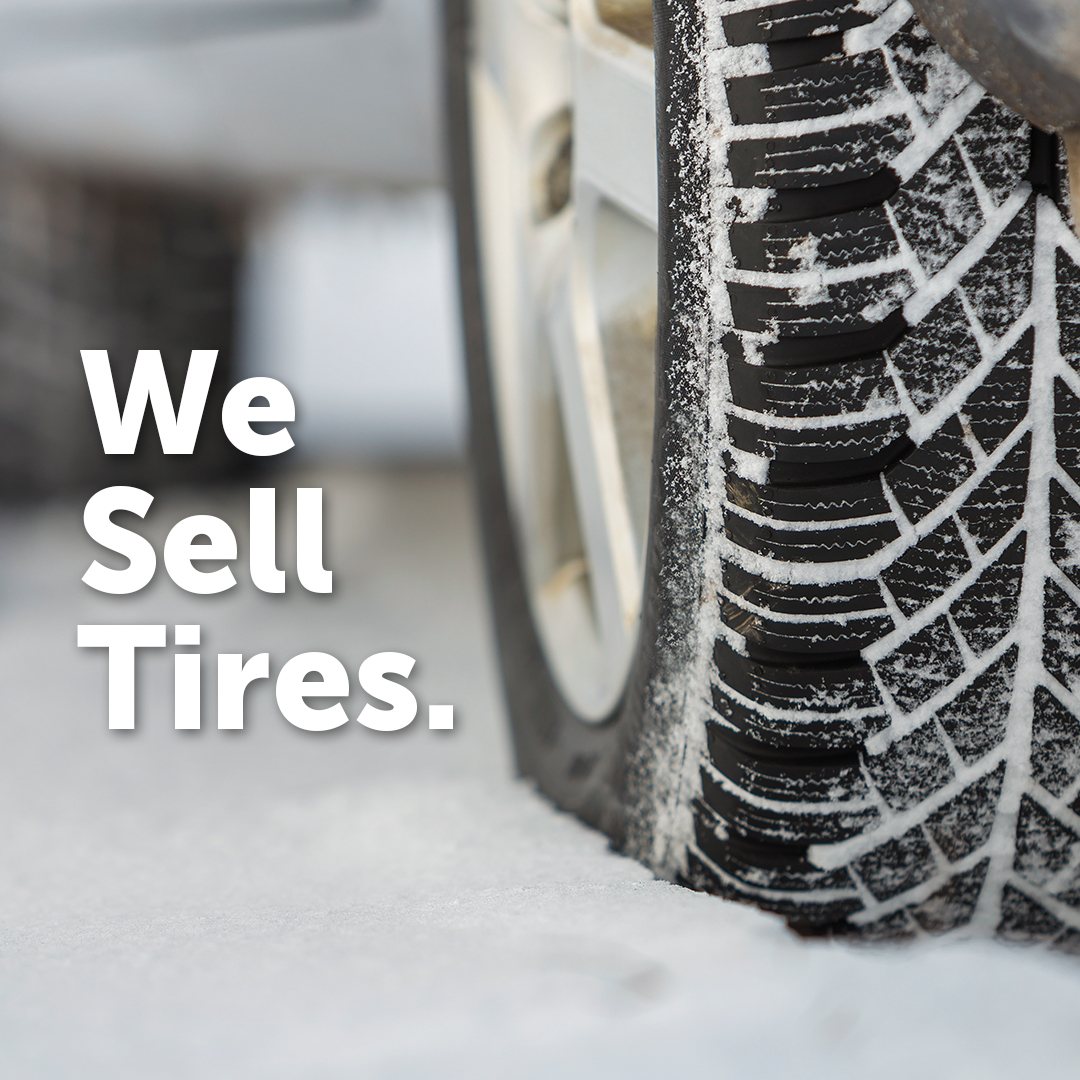
Get Your Tire Studding Done Here!
Serious winter conditions call for studded tires
Studded tires are equipped with tiny metal studs designed to “stick out” past the tire tread. These metal studs dig into ice and packed snow, giving you improved traction in less-than-ideal driving conditions. Tires that bite into ice. Getting studded tires. Some off-road tires are studdable. Studded tires perform the best on icy roads. Period. Why is stopping power better on studded winter tires? It’s all in the name. These tires allow for studs to be installed across the tread face, giving drivers better side-to-side and front-to-back grip. This kind of traction is critical on ice. If you live in an area with unpredictable weather, studded tires are a good idea.
Contact us to book your appointment to get your tires studded at Canadian Auto/Napa Auto Care Centre 780-569-0654.
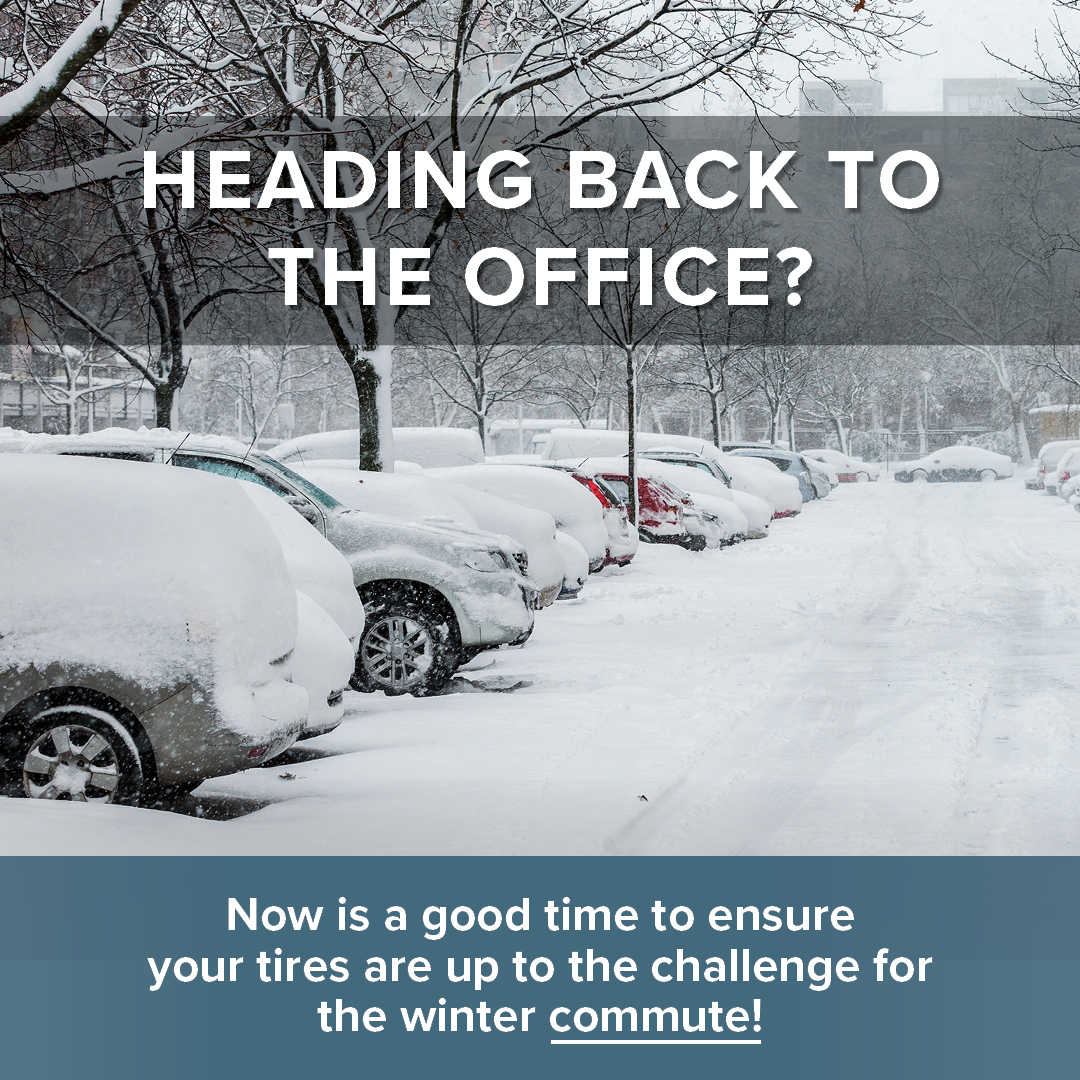
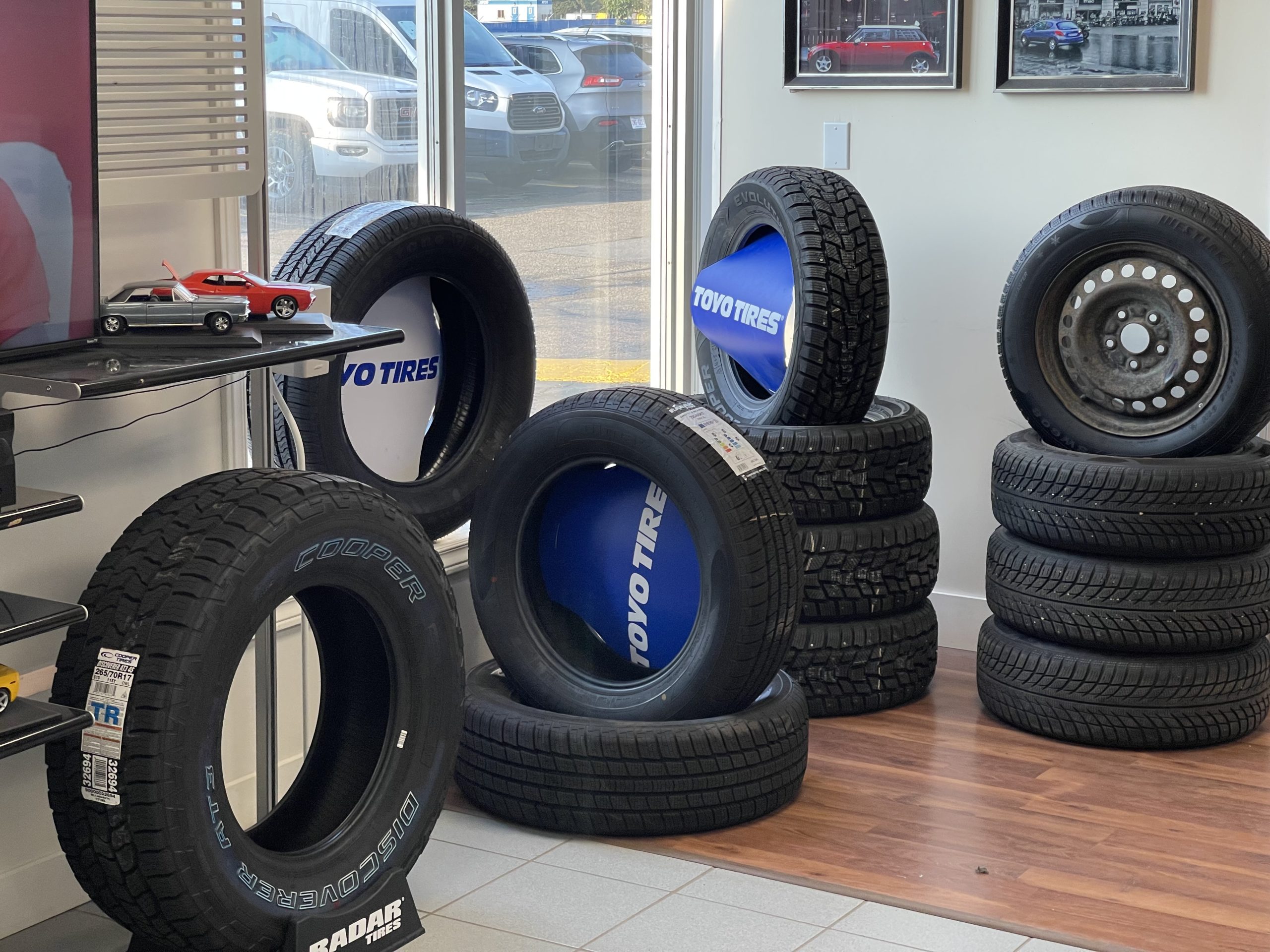
Rely on the Three-Peak Mountain Snowflake Symbol (3PMS)
Motorists have a broad range of options for winter driving. TRAC recommends winter tire shoppers rely on the Three-Peak Mountain Snowflake Symbol (3PMS). Tires with this symbol meet or exceed government and industry snow traction standards.
Tire options for winter
Drivers have three choices for winter driving: all-season tires; all-season tires with the 3PMS symbol and dedicated winter tires designed exclusively for winter. Selecting the right tire can mean the difference between a surefooted winter motoring experience and a nervous drive.
Why dedicated winter tires are best
Driving on all-season tires in winter months results in longer stopping distances and compromised handling when temperatures fall below 7°C. All-season tires with 3PMS offer moderately better traction than other all-season tires. But they are designed for occasional, medium snowfalls and may not provide the grip needed for severe winter driving conditions common on Canadian roads. Dedicated winter tires feature softer tread compounds that retain their elasticity even in extremely cold temperatures. They provide superior traction and significantly shorter stopping distances in all winter driving conditions from icy, slushy, and snow-covered roads to cold, dry pavement. Dedicated winter tires are the best performers and are by far the safest choice.
Choose the Right Tires and Make Them Last
Finding Your Perfect Tire Match
When choosing new tires, it’s important to think about three things: Vehicle fit, driving conditions and performance preferences. Tire manufacturers offer you a world of possibilities when it comes to meeting your personal driving preferences, be it prioritizing fuel economy, ride comfort, superior grip or others. No one tire can do it all, so choose the right tire for your ride. To enjoy the handling and performance that your vehicle is designed to deliver, follow manufacturer guidelines for tire size, speed rating and load rating.
Eight-in-Ten Canadian Drivers Believe Investing in Winter Tires is Important Despite Rising Living Costs:
Regional findings:
- 59 per cent of British Columbia drivers use winter tires
- Alberta’s usage rate is 56 per cent
- In Saskatchewan usage stands at 61 per cent
- Manitoba’s usage rate is 54 per cent
- 65 per cent of Ontario drivers now use winter tires
- In Atlantic Canada winter tire usage stands at 74 per cent
WHEEL AND TIRE TERMS GLOSSARY
Air pressure – The measure of the force exerted by the air inside a tire, measured in pounds per square inch (psi)
Aspect ratio – The relationship between a tire’s section height and its section width. It is calculated by dividing the section height by the section width. When the section height is half of the section width, the aspect ration is 40. In a tire size description, it would be the 40 in P205/40r16. It is also called the tire’s profile or the series.
Asymmetric – Tires that have differing tread patterns on each half of the tire
Camber – The angle of the centerline of a tire and wheel relative to completely vertical.
Cast – Wheels that are made from liquid metal being poured into a mold. Low pressure casting involves pouring into a mold, while counter pressure casting involves sucking the metal into the mold like a vacuum. The counter pressure technique reduces impurities making the wheel much stronger than a low pressure cast rim.
Caster – The angle between the vehicle’s steering pivot axis and completely vertical.
DOT – Stands for Department of Transportation. The 10-digit code appearing after the DOT designation gives information such as the week and year the tire was produced, as well as the manufacturer, plant, tire line, and size.
Forged – Considered to be the best wheel manufacturing technique, forging allows for the compression of an aluminum billet (one solid piece of aluminum) into an aluminum wheel using over 13 million pounds of pressure combined with heat. This produces a wheel that is both stronger and lighter than your standard aluminum wheel.
Hub centric – A wheel with a center bore made to match up with a vehicle’s hub diameter.
Hub rings – Hard plastic or aluminum rings mounted on a vehicle’s hub before the wheel. They ensure the wheel is perfectly centered on the vehicle’s hub. Without hub rings, there is a possibility of getting a vibration even if the wheel & tire assembly is perfectly balanced.
Load index – A number used to represent the maximum weight a tire can support. The index number corresponds to the actual load carrying capacity. Truck tires use a different system incorporating letter codes to establish a Ply Rating.
M+S – A sidewall marking indicating that the tire is approved for Mud & Snow use.
Mounting – Installing tires onto wheels
Over inflation – When a tire is inflated more than the recommended vehicle air pressure. This might be done for better performance but has negative consequences including a less comfortable ride, damage to the tires and stress on the suspension.
P – Metric system – a system for specifying tire sizes using the tread width (millimeters), the aspect ratio, type or tire construction and the rim diameter (inches). The sizes are written as such: P195/50R15
Plus, sizing – Changing from the original stock tire size of your vehicle. Plus sizing your wheel & tire combination was designed to enhance vehicle performance and looks by allowing fitment of larger diameter rims and lower profile tires. The theory is that while making these changes, you keep the overall tire diameter within 3% of the original equipment tires. This is important because larger variances can cause problems with transmission shift points which can decrease fuel mileage. It can also confuse braking system computers which can even lead to brake failure.
PSI – The most common measurement unit for tire pressure. It stands for pounds per square inch and it measures the force exerted by the air inside a tire.
Radial tire – Tires built with plies running perpendicular (90 degrees) across the crown of the tire. To strengthen the tread, these tires require belt plies going circumferentially around the tire.
Rim width – The measurement between the flanges of a rim
Rotation – Moving a vehicle’s tires from left to right and from front to rear. This is done in a set pattern and should be done periodically. Its purpose is to prevent uneven tire wear and to extend tread life.
Section width – The distance between the sidewalls at their widest point of an inflated tire not under load.
Sidewall – The side portion of a tire between the tread and the bead. >More Info
Speed rating – A letter that identifies a tire’s high-speed durability. A tire’s capabilities are tested at pre-set speeds and the results of these tests determine the tire’s speed rating. Speed Ratings include: Q, S, T, U, H, V, Z, W, Y
Tire sizing guide – A guide to provide the correct tire size.
Tread depth – The distance from the top of the tread to the grooves in a tire. This measurement is taken at the centerline of a tire and is measured in thirty-seconds of an inch.
Tread pattern – The arrangement of grooves, blocks, Sipes and channels on the tread.
Tread shaving – Thaving some of the tread from a tire for optimal performance and durability in racing applications.
Tread wear – Also called the tread life, it is the measure of how long a tire last. It is measured in miles or kilometers.
Tread wear indicators – Narrow rubber bars built into the tread grooves that define the tire’s legal wear out point. Also called the wear bars, they are even with the tread when 2/32″ of tread is left and then the tires are ready to be replaced.
Tread width – The width of a tire tread normally measured in millimeters. In 195/50R15 the tread width is 195mm.
Underinflation – A tire with less than the recommended air pressure for a given load. This may lead to tire rollover and deflection.
UTQG – The Uniform Tire Quality Grading rating is a quality rating system developed by the American Department of Transportation. It is designed to tell consumers the relative performance of passenger tires
Wheel Alignment – Refers to the correct angle settings of suspension components – the 3 alignment settings are caster, camber, and toe.
Wheel Backspacing – Also called rear spacing, it is the distance from the mounting pad to the back edge of the rim. This is different than wheel offset.
Wheel Balance – Equal distribution of the weight of a tire and wheel. If a tire & wheel is not balanced it can lead to vibrations or uneven wear. For balancing, weights are attached to the wheel to compensate for uneven weight distribution.
Wheel Bolt pattern
the arrangement of the bolt holes on a wheel. A 5-bolt wheel with 120mm between opposite bolt holes would be written as 5×120. Some wheels have more than one bolt pattern on the same wheel to accommodate multiple fitments.
Wheel Centerbore – The center hole in the wheel that centers the wheel on the hub of the car. Since most wheels are mass produced, they have a large center bore to accommodate several different vehicles. If this is the case, it is recommended that you use a hub ring. Hub rings are hard plastic or metal ring that fits between the wheel and the vehicle. This centers the wheel perfectly on the hub ensuring that there is no run out when the wheel is installed on to the vehicle. Without hub rings it is possible to get vibrations even if the wheel / tire assembly is perfectly balanced.
Wheel fitment tool – A website designed to calculate which wheels will fit best on a vehicle.
Wheel guide – An arrangement of wheels on a site specifying wheel diameter, wheel center bore, wheel bolt pattern, wheel lug nuts, and wheel finish.
Wheel offset – The offset of a wheel is the distance from the mounting surface of the wheel to the true centerline of the rim. A positive offset means the mounting surface of the wheel is positioned in front of the true centerline of the rim / tire assembly. This in effect brings the tire in to the fender well more. Conversely, a negative offset means the mounting surface of the wheel is behind the true centerline of the rim / tire assembly. This will cause the tire to stick out away from the vehicle.
Wheel weights – Weights attached to a wheel to balance a tire & wheel. The weights can be on the inside or outside of the wheel and can be clipped, taped or self-adhered to the wheel.
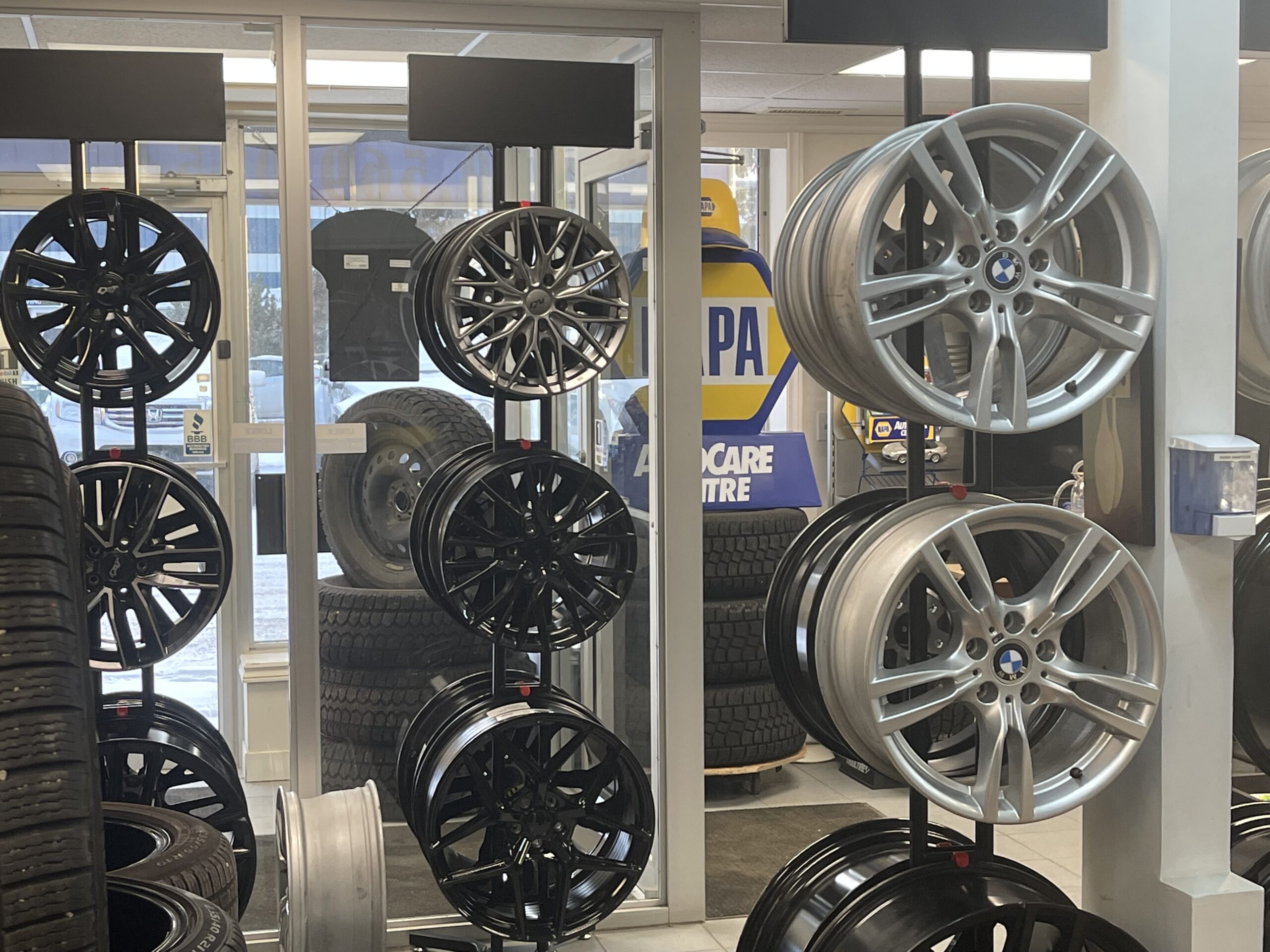
When it comes to truck tires, Performance Trade-offs. all tires represent trade-offs in performance as well as appearance. Truck tires exist on a spectrum from Sport Truck to
- H/T (Highway Tread)
- A/T (All Terrain)
- R/T (Rugged Terrain)
- M/T (Mud Terrain).
All these segments serve a specific set of performance attributes.
A/T tires must focus on great off-road performance and an aggressive appearance, while H/T tires should focus on a smooth and quiet ride. A great A/T tire will find the right balance between aggressive off-road and reasonable on-road manners.
The A/T tire’s aggressive tread pattern allows for more traction off-road and is especially suited for consumers who frequently take their vehicle off-road for recreation or work. In addition to the pattern differences, A/T tires generally have deeper tread depths which aid in their off-road capabilities. The combination of the pattern and deeper tread depth leads to some trade-offs, specifically noise and ride; A/T tires will be louder and will ride rougher than their H/T counterparts.
At one end of the spectrum, A/T tires are almost like H/T tires, especially for OE A/T fitments due to the requirements for rolling resistance and noise imposed by the OEM. At the other end of the spectrum, A/T tires are very aggressive with very deep tread depth and, yes, louder.
Can nitrogen be mixed with regular air in tires? Nitrogen is always compatible with air. So, the answer is, yes! You can mix air and nitrogen in tires.
Nitrogen is a good product for your tires but Consider the Disadvantages of using nitrogen as they supersede the advantages. It is Costly, it is expensive to fill your tires with nitrogen. The nitrogen service stations will charge a minimum of $5 or more per tire to top-up. Top-up stations are rare and hard to find a location close to you or if you are driving out of town it will be very difficult to find a shop that provides Nitrogen services. The nitrogen filling stations are not readily available.
Canadian Auto/Napa Auto Care Centre Winter and Summer Tires & Wheels for sale in St Albert, AB.
Canadian Auto/Napa Auto Care Centre and Tiremotive Tire Shop approved facility providing a new standard in automotive service excellence in St Albert, supplies and installs the top tire brands that you know and trust for all passenger cars, trucks, SUV’s and minivan tires from domestic to import vehicles, our lineup of proven tire brands includes Michelin, Uniroyal, Yokohama, Pirelli, Toyo, Kleber, Rakla, Nexen, Kelly tires, Goodyear, Samson, Laufenn, Kenda, BFGoodrich, Bridgestone, Continental, Dick Cepek, Dunlop, Falken, Fierce, Fuzion, GT Radial, Starfire, Firestone, Mickey Thompson, Hercules tires, General tire, Ironman, Westlake tires, Cooper tires, kumho Tire, Nitto, Hankook, Dayton, Nankang, Titan, Sumitomo Tire and many other leading tire brand names.
Check your tire pressure monthly! Tire Maintenance Done Right.
To make your tires last longer, perform better and save you money on fuel, be sure to regularly inspect and care for them.
Your vehicle’s tires support 95% of the vehicle’s weight and impacts almost every aspect of handling and performance. That’s why maintaining and monitoring your tires’ inflation is so critical to getting the most out of your tires and keeping you safe.
Improperly inflated tires can impact everything from ride quality to fuel efficiency and performance. 🚗 You can find the recommended inflation pressure for the tires on your vehicle’s placard (normally located on the edge or the inside post of one of vehicle’s doors, or inside the glove compartment, trunk, or fuel door).
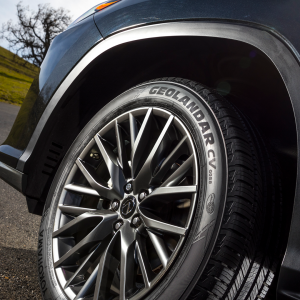
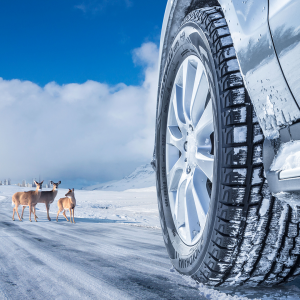
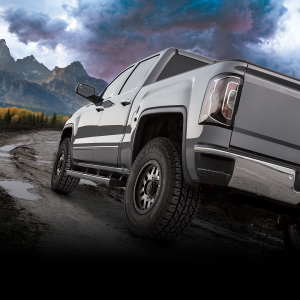
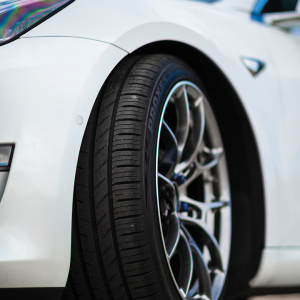
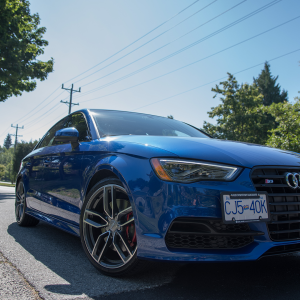
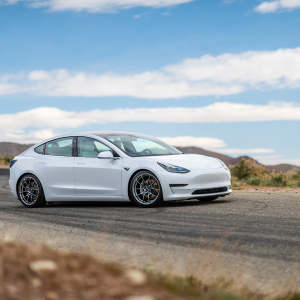
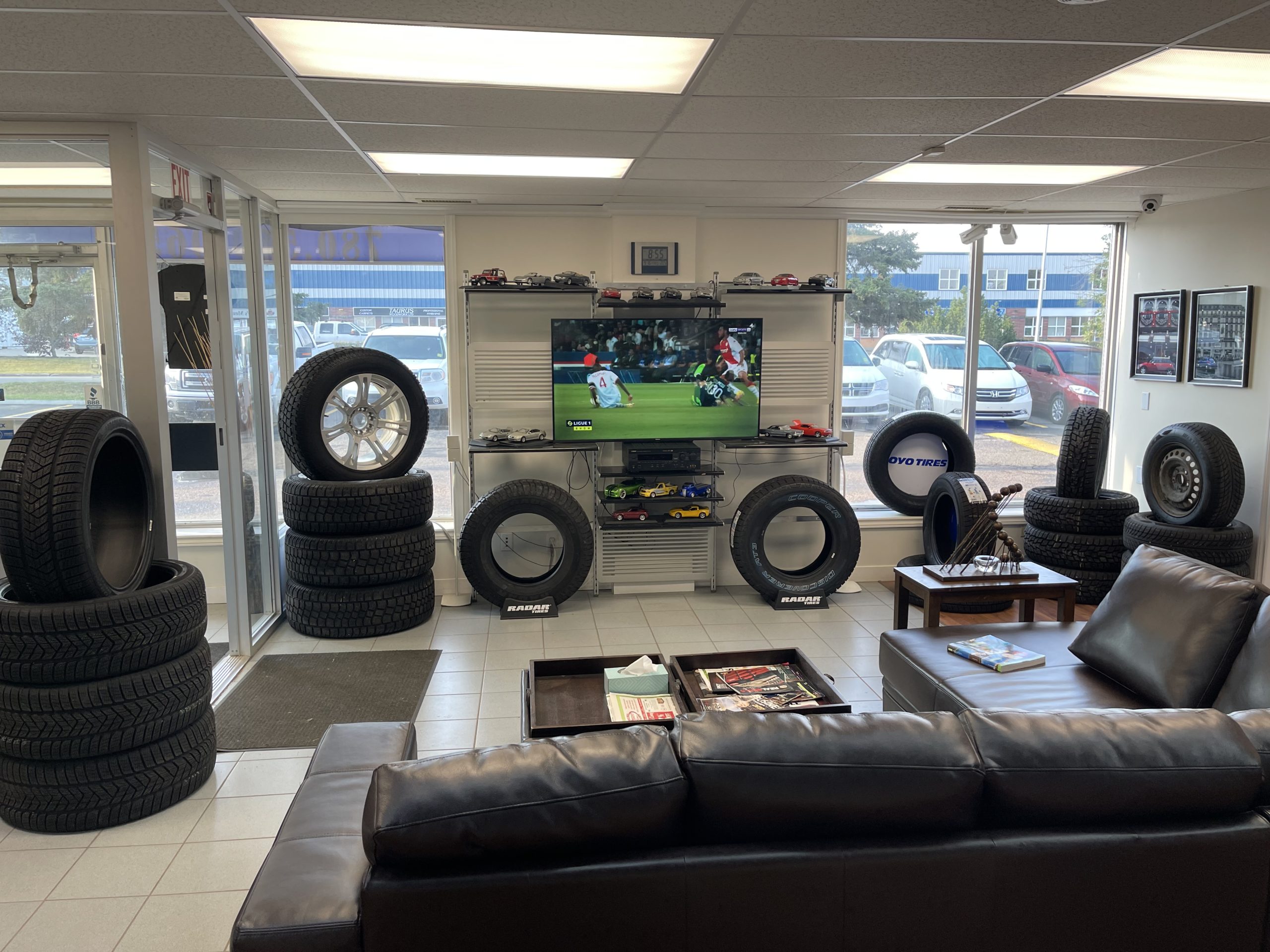
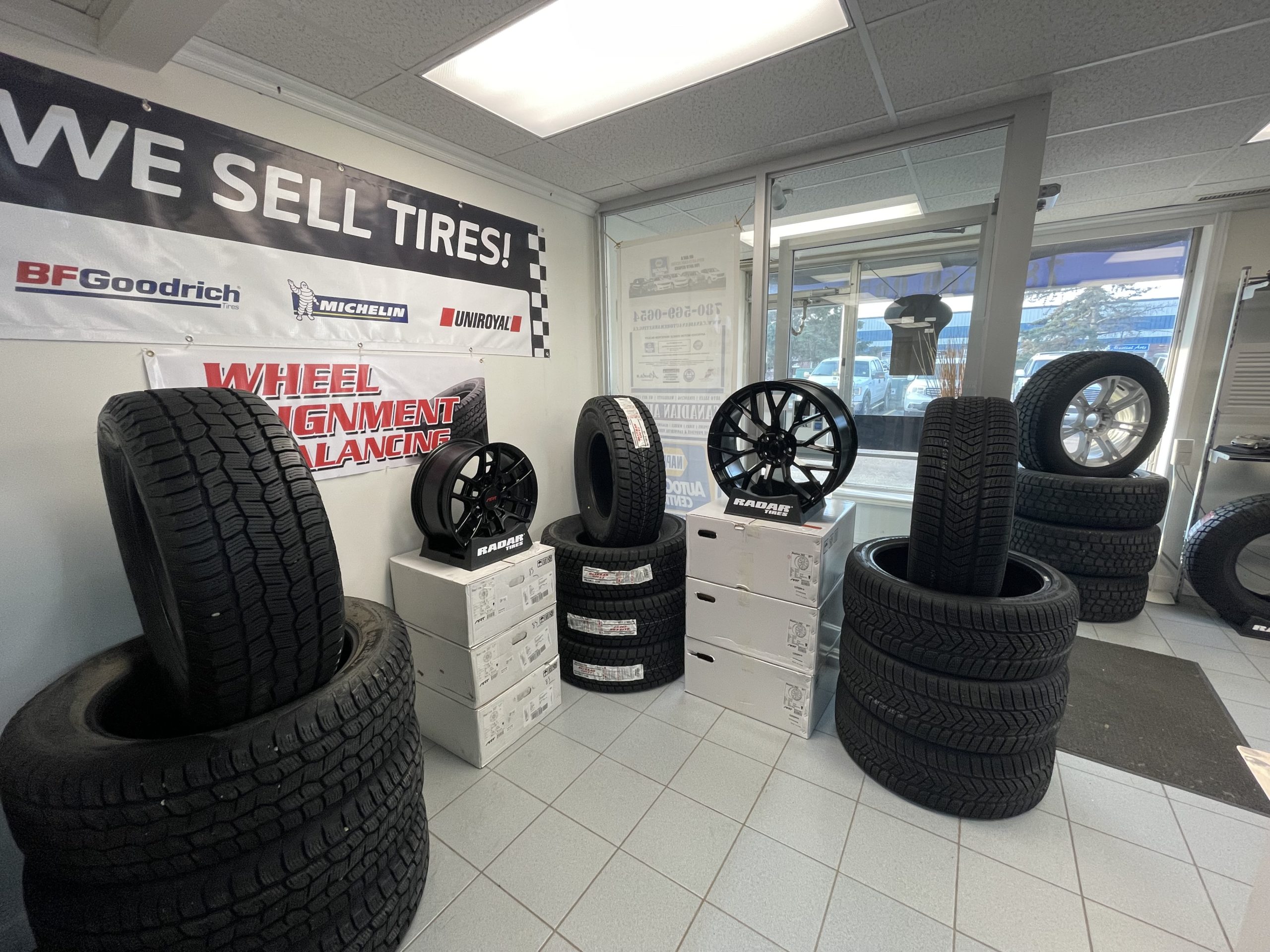
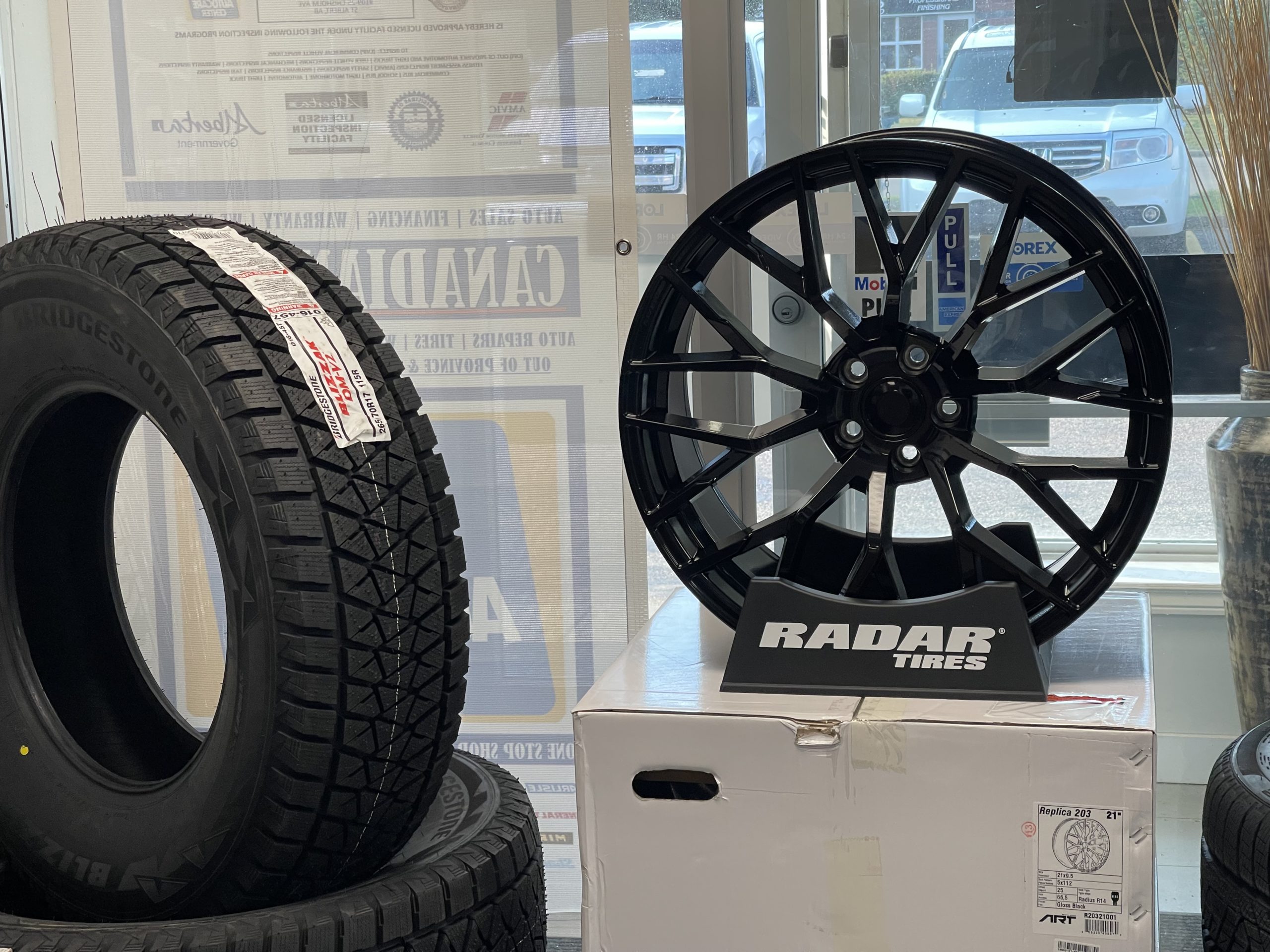
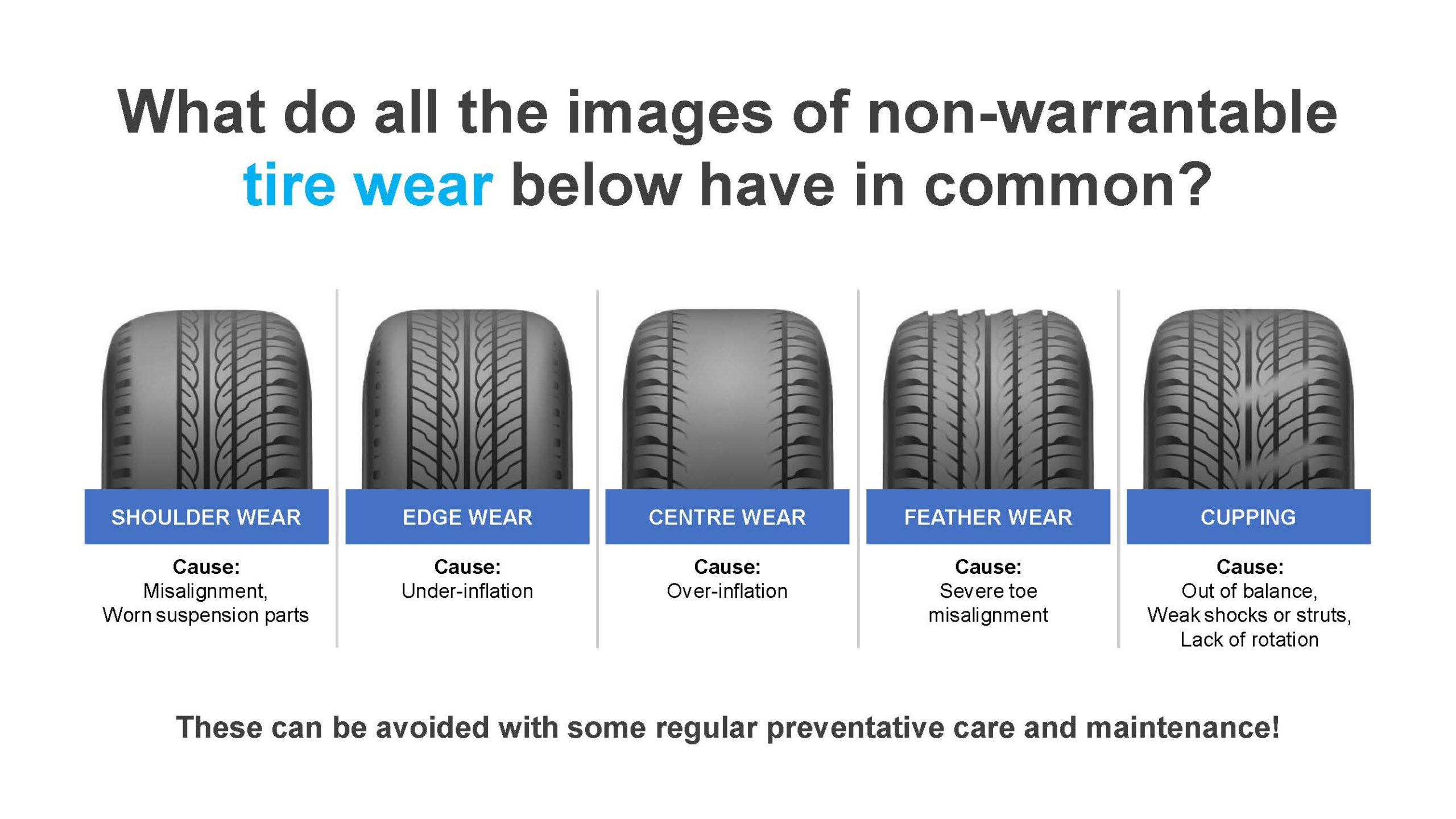
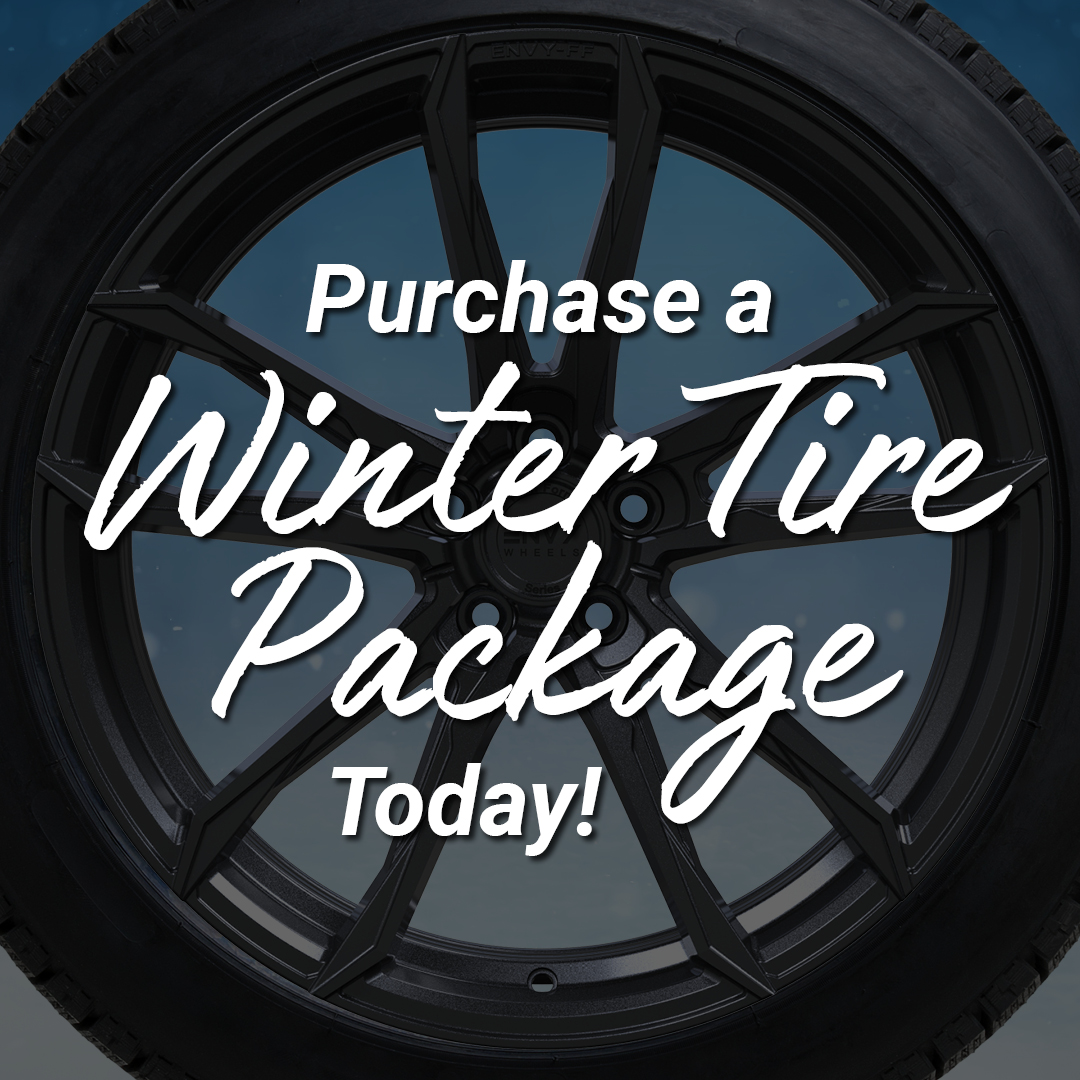
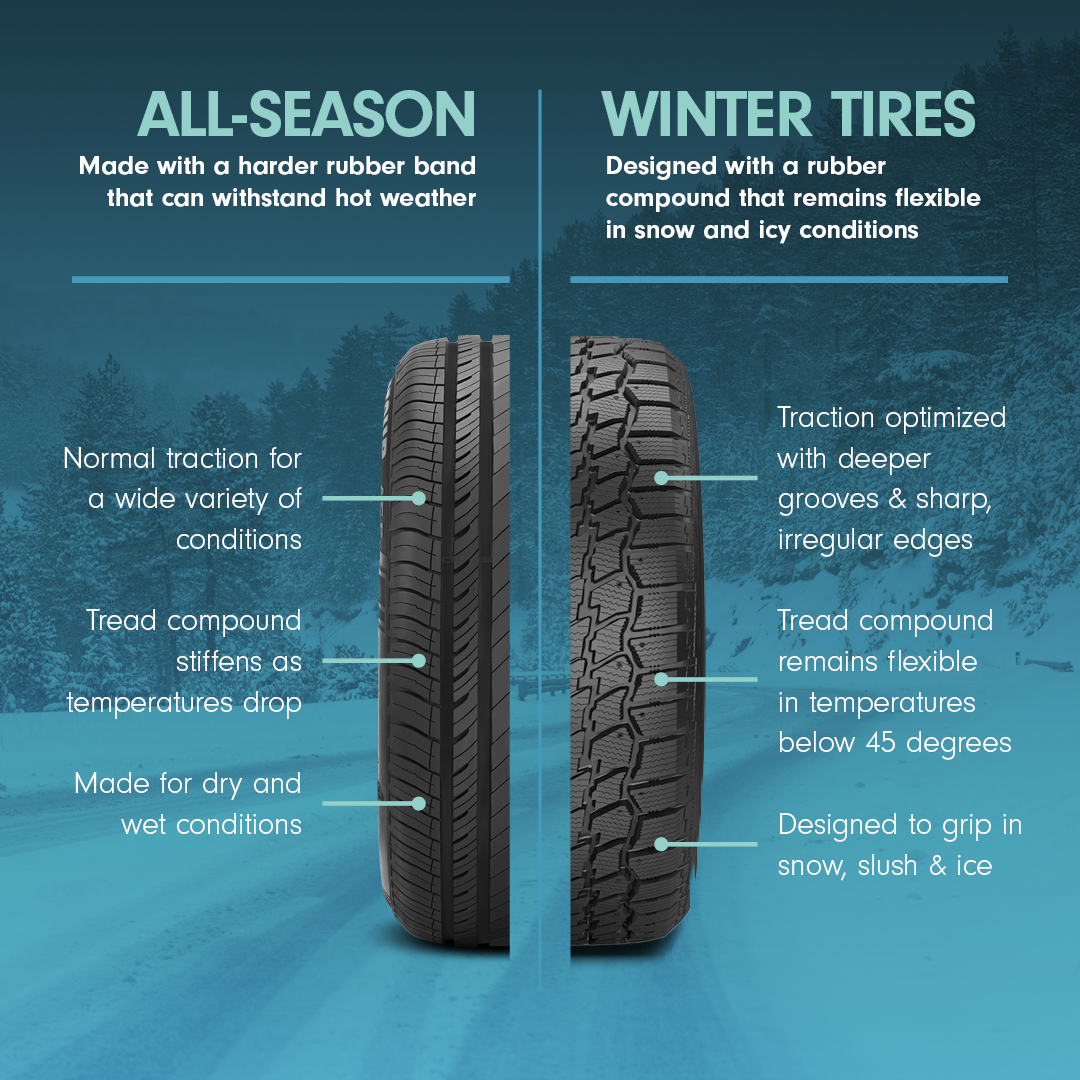
- The winter season is approaching ❄️ start your winter right with savings.
- Get a mail-in rebate with the purchase of 4 select new passenger or light truck winter tires. Ask us for a full list of winter tire rebates!
- If you need a new set of tires this winter, now is the perfect time. Get up to $100 in rebates when buying an eligible set of winter tires. Visit us at Canadian Auto/Napa Auto Care Centre to start your winter right 📲 780-569-0654
- #tire #tirechangeover #wintertires #winter #tirestorage #winterseason #safety #wintersafety #rebates #allweather
Tire Rotation
Best practice for making sure your tires avoid sudden failures and keep working properly, is tire rotation.
Did you know that you should have your tires rotated every 10,000 kilometres? This ensures that your tires don’t have sudden failures and that your tires last longer.
Below -7 Degrees
Tire rubber will begin to stiffen as the weather gets colder. Winter tires maintain their elasticity even at extremely low temperatures approaching -30°C and below, thus providing superior traction and grip.
Installing winter tires will improve surface grip in every type of road condition at temperatures below 7°C.
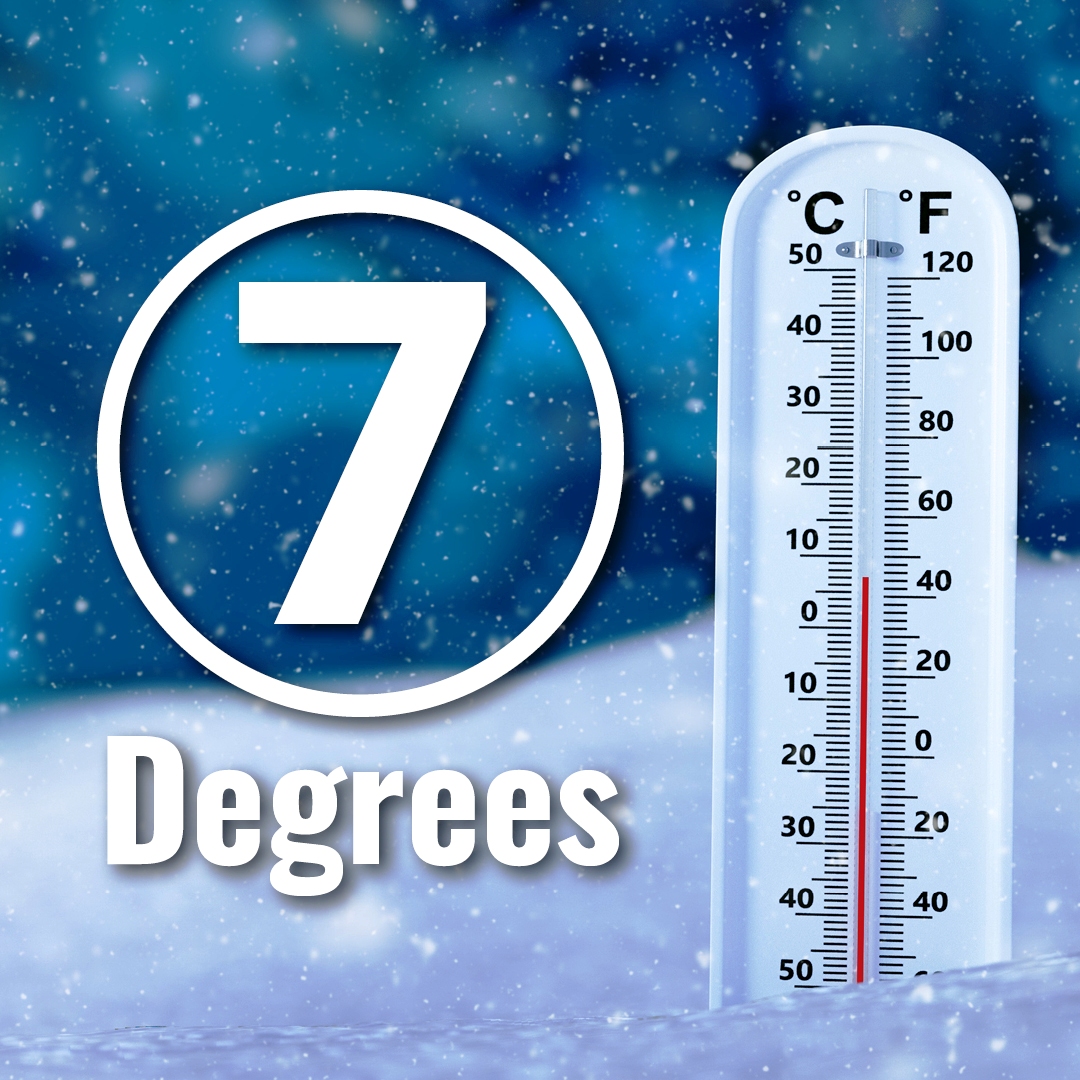
All-Season tires
All-Season tires offer decent grip in most conditions but are optimized to deliver long tire life and good fuel economy. 🚘
The downside of low tread wear and low rolling resistance is all-seasons’ harder rubber compound, which loses pliability as temperatures drop.
As soon as you have a cold rubber compound on cold pavement, your stopping distances are greater, your cornering isn’t as crisp. If it is cold, performance is degraded.
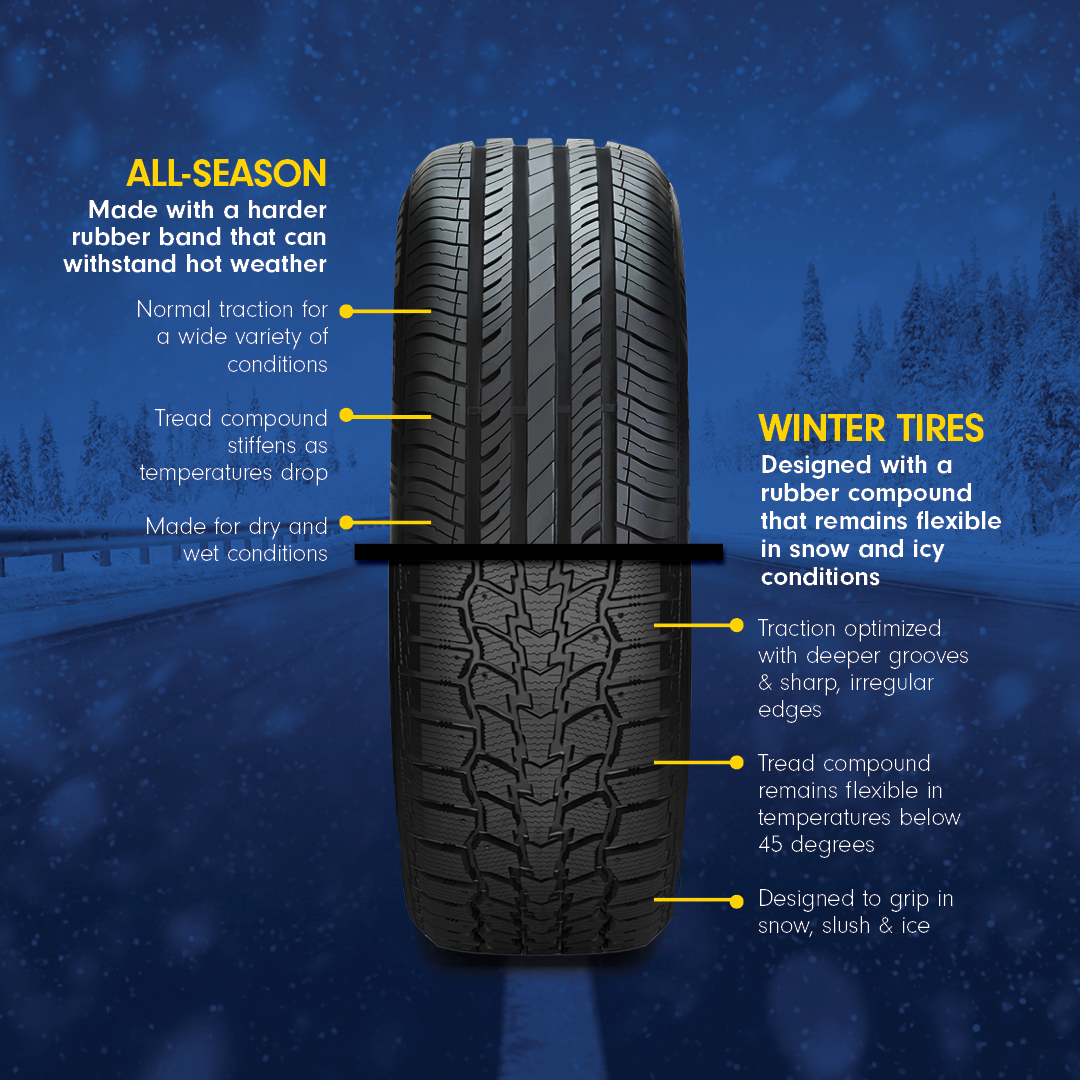
Fuel Efficiency.
Tire industry research shows that one third of drivers typically have at least one tire underinflated by more than 10%.
Tip: measure your tire pressure monthly and do not rely on visual inspections to determine the correct inflation pressure – a tire can be underinflated by 20% or more and look normal.
Want to learn more about the best tires for fuel efficiency? Give us a call today 🤙 780-569-0654
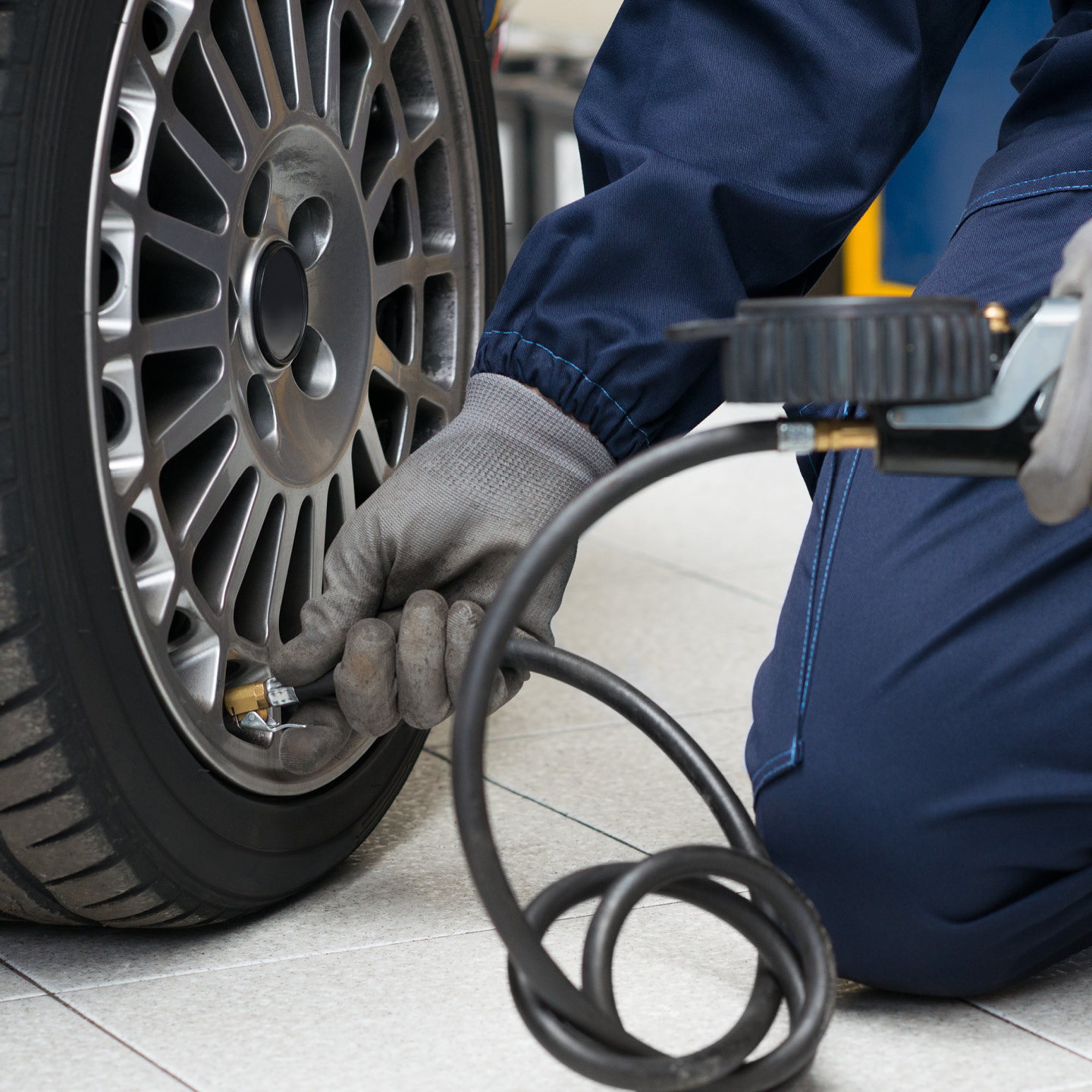
Replace your tires?
All tires sold in Canada are manufactured with “wear bars”.
These colored bars become exposed when there is less than 1.6 mm of tread depth remaining on your tire. Tires must be replaced when the wear bar is visible.
Consult your tire technician for more information on when to replace your tires.
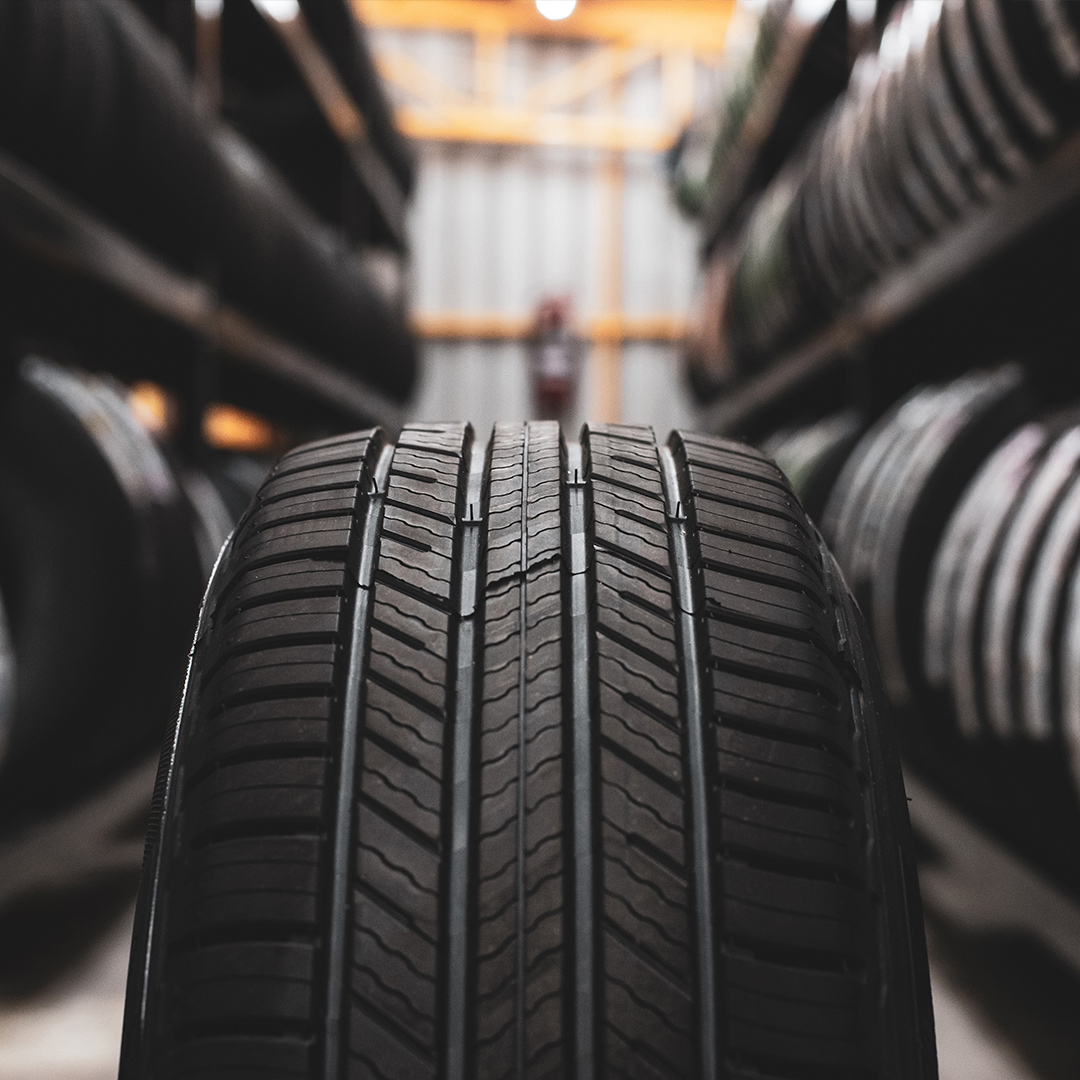
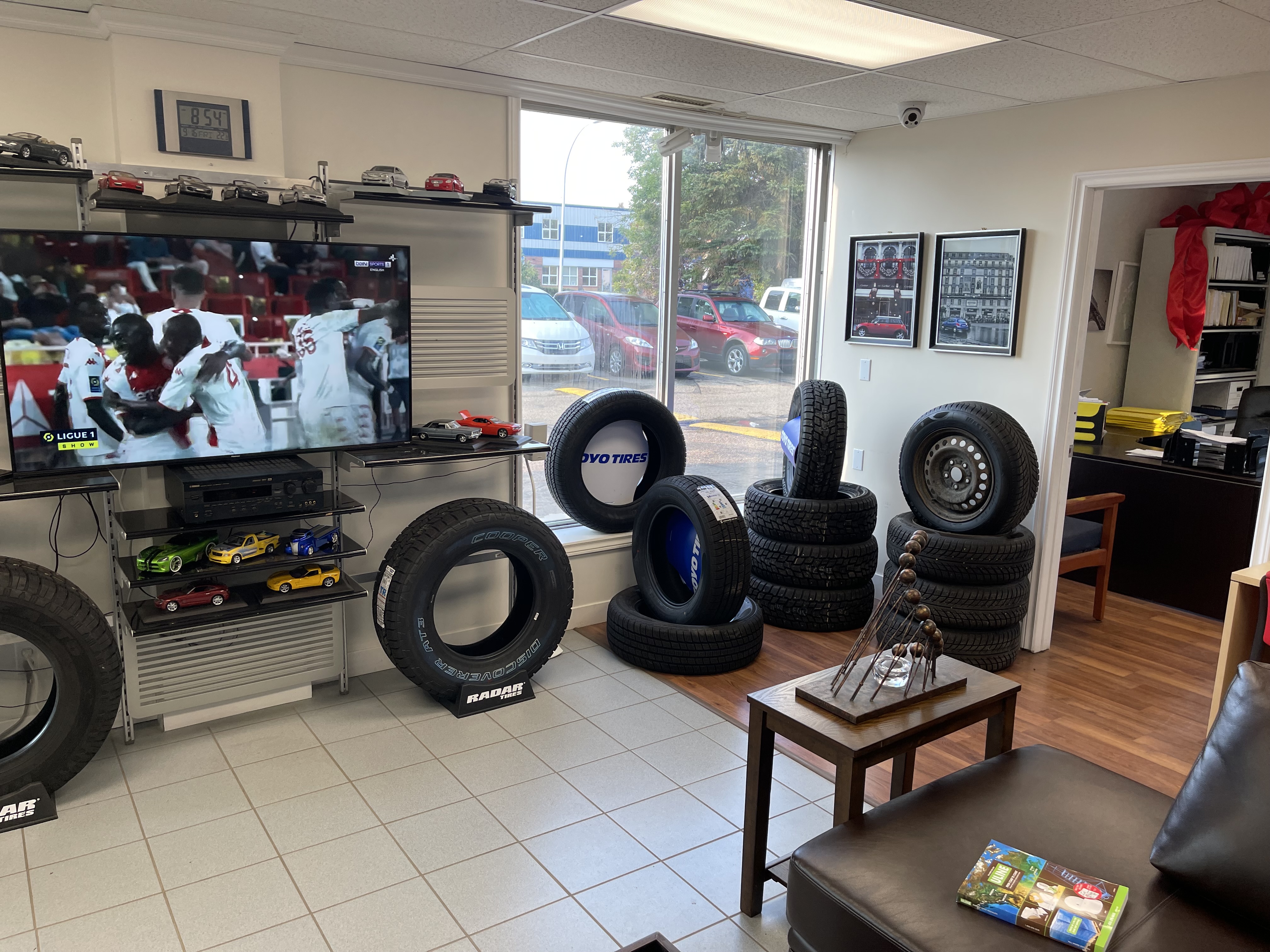

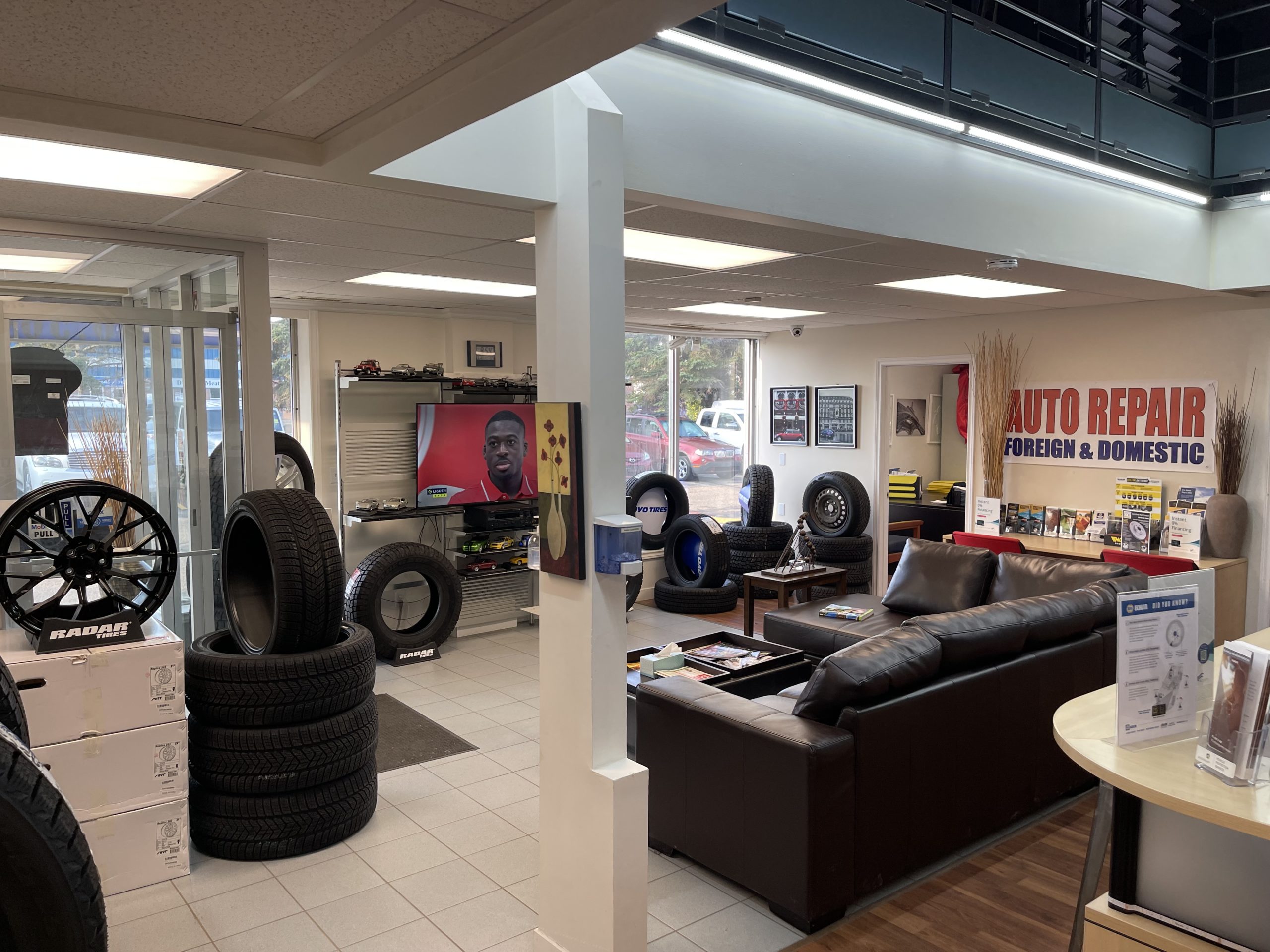
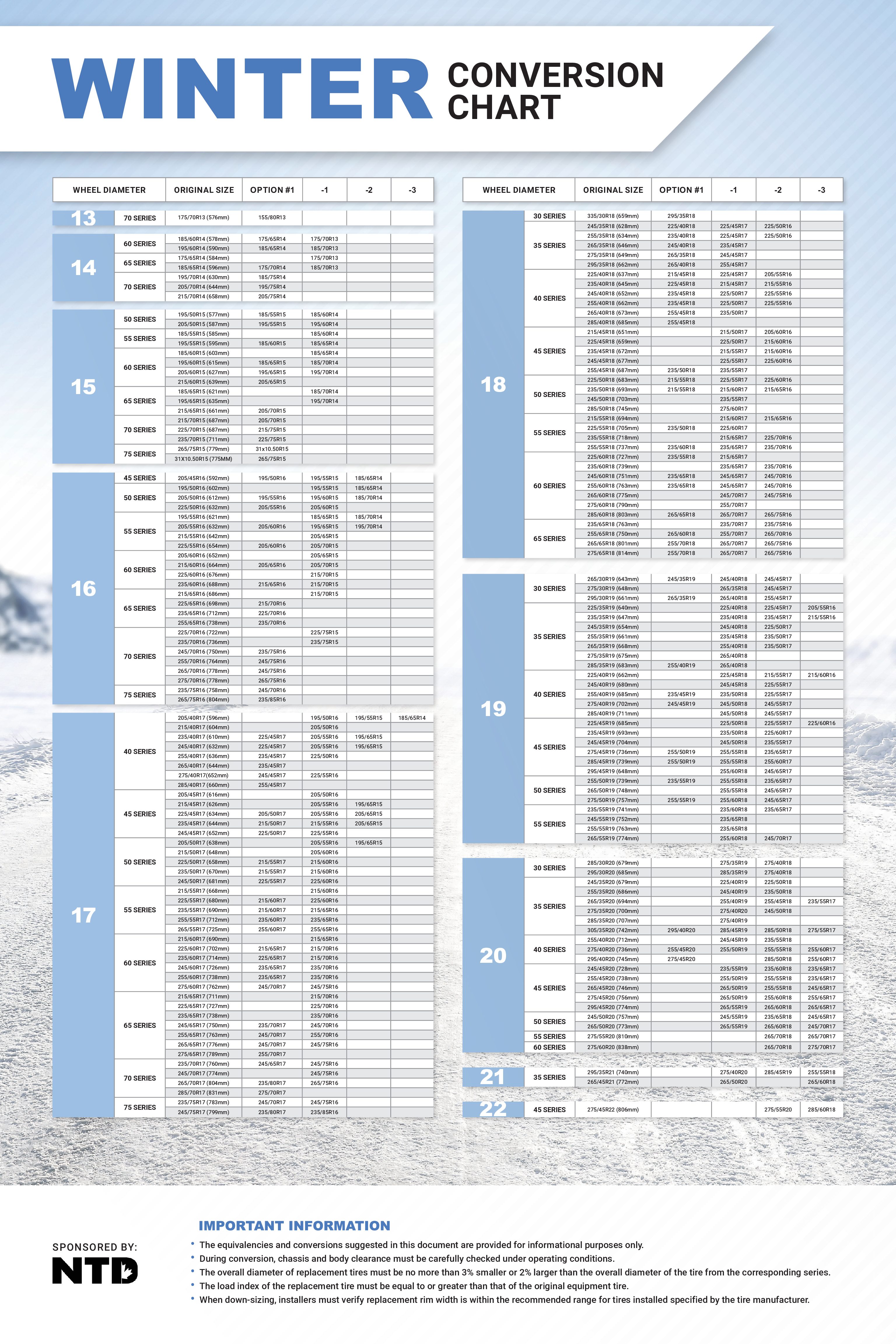
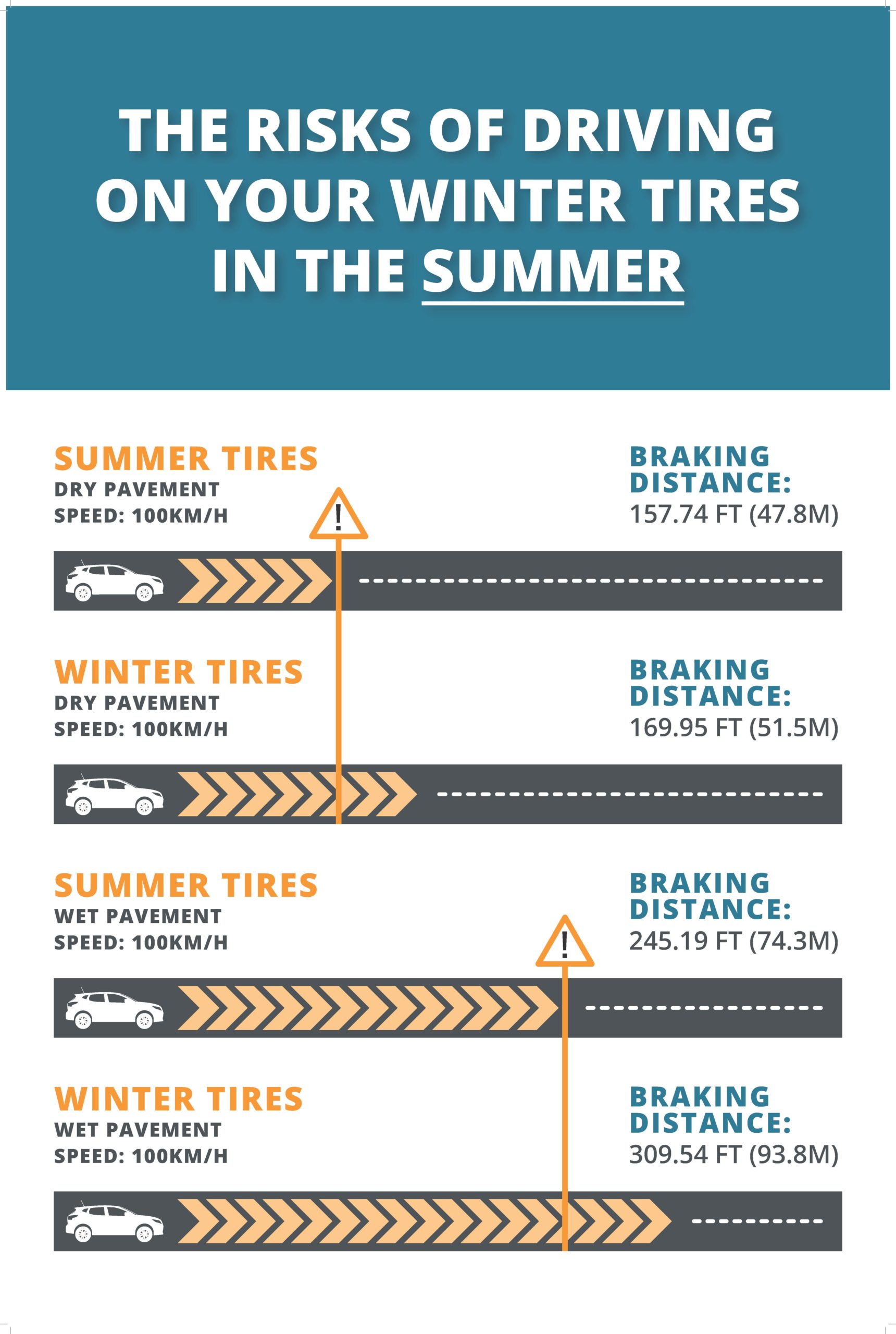
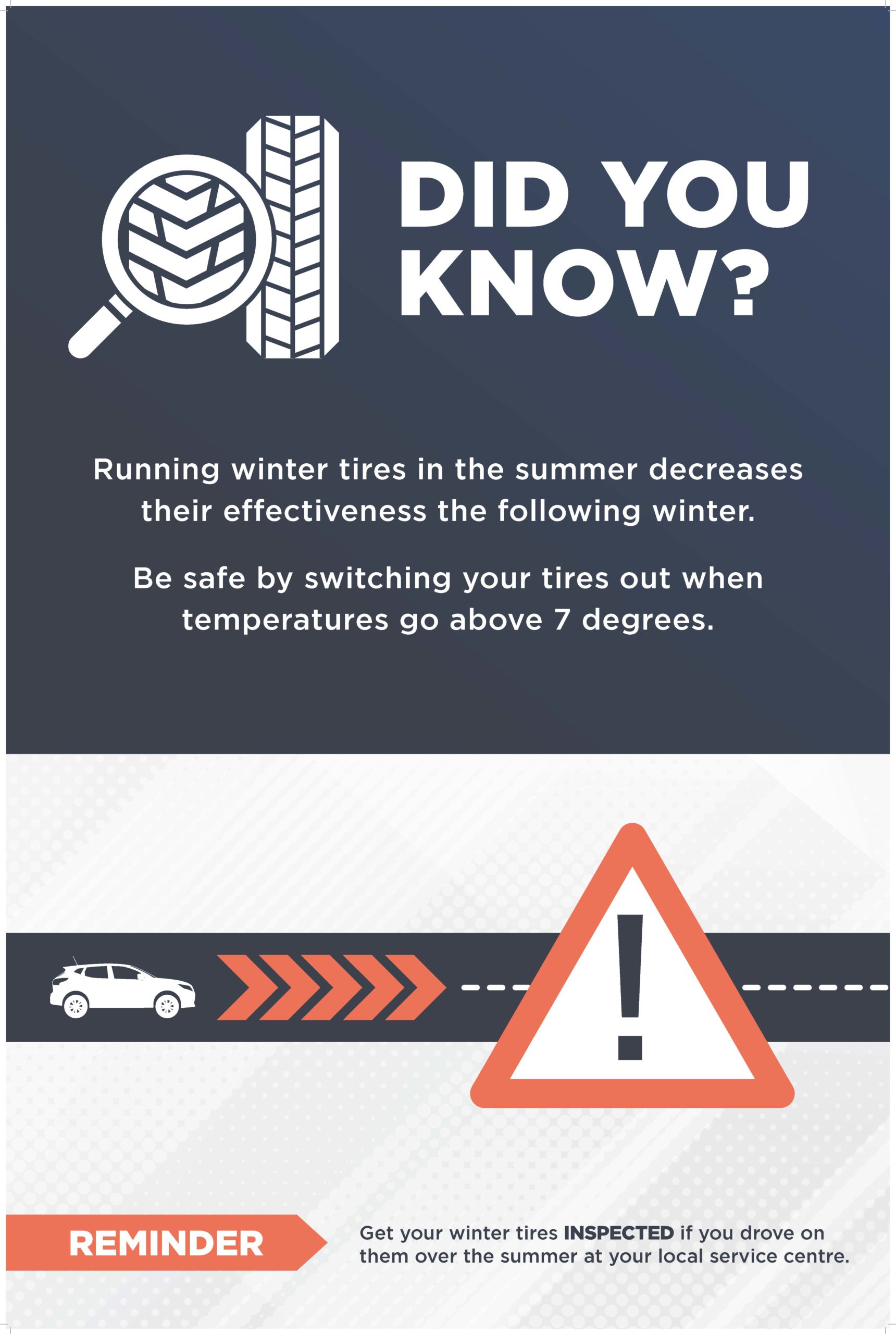
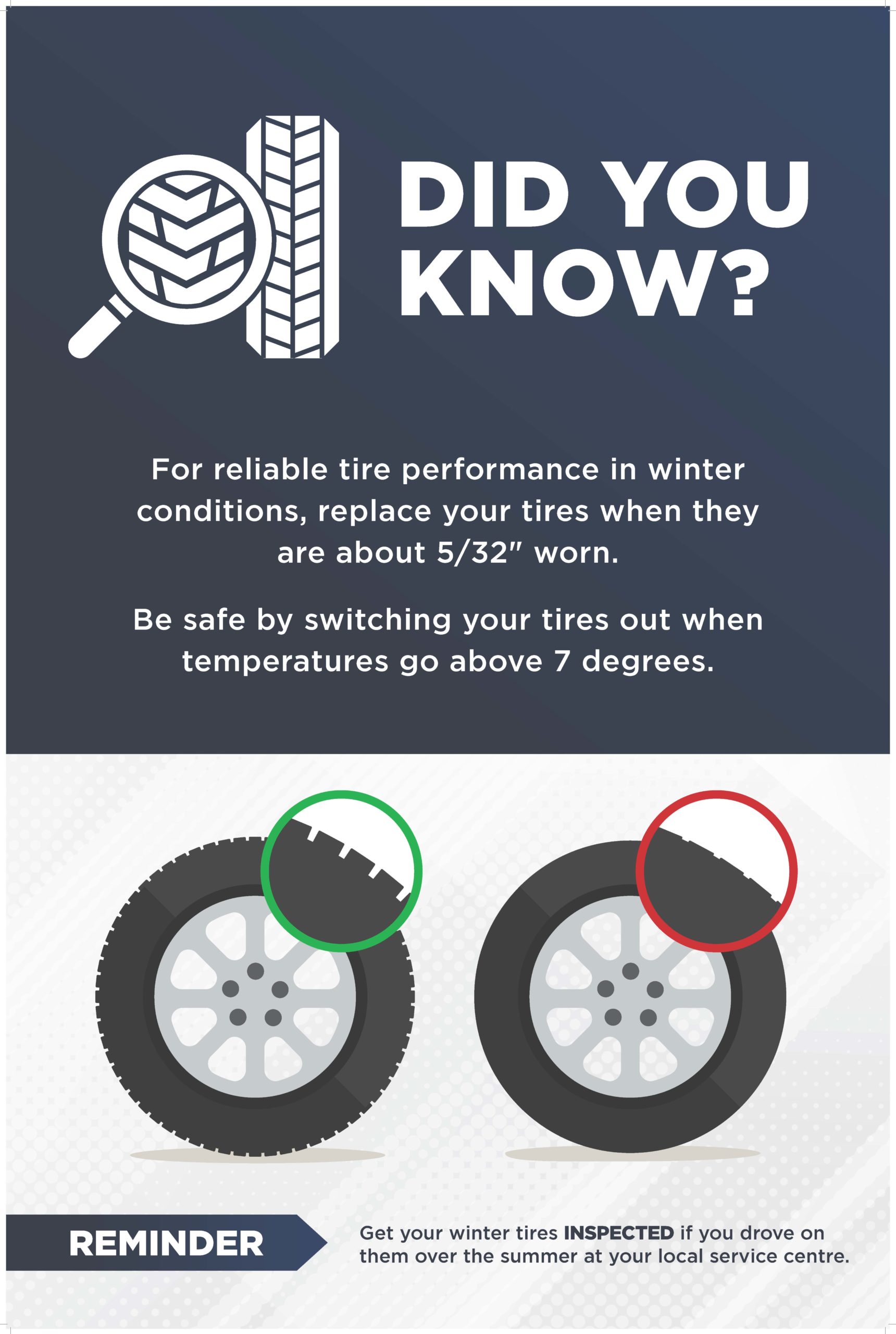
Canadian Auto/Napa Auto Care Centre Service Repairs and Tire Shop proudly serves the Cities of St. Albert, Edmonton, Spruce Grove, Stony Plain, Sherwood Park, Morinville, Fort Saskatchewan, Devon, Leduc, and surrounding metropolitan areas! From imports, domestic, sports vehicles, trucks, SUV’s, sedans, minivans, convertibles, all makes and models like; Acura, Audi, BMW, Buick, Chevrolet, Cadillac, Chrysler, Dodge, Fiat, Ford, General Motors, Honda, Hyundai, Infiniti, Jeep, Kia, Volvo, Lincoln, Land Rover, Lexus, Mazda, Mercedes Benz, Mini, Mitsubishi, Nissan, Porsche, Ram, Subaru, Toyota and Volkswagen.
Canadian Auto/Napa Auto Care Centre provides complete wheel alignment, tire balancing and tire changes services on all vehicle makes and models, from imports to domestics.
Hunter HawkEye Elite® Wheel Aligner. Align accurately the first-time using Hunter’s award-winning WinAlign® software. Our shop is equipped with Hunter wheel alignment machine which specializes in complete wheel alignment systems and it is the most powerful wheel alignment machine on the market today. Four precision cameras provide alignment measurements with pinpoint accuracy. Clamps hook tires and protective ring provides no metal-to-metal contact to avoid rim damage.
Looking for the best deals on Lift Kits, levelling kits, big tires and custom wheels in Edmonton and St Albert areas? Canadian Auto/Napa Auto Care Centre supplies and installs Lift Kits and levelling kits for all trucks and SUVs.
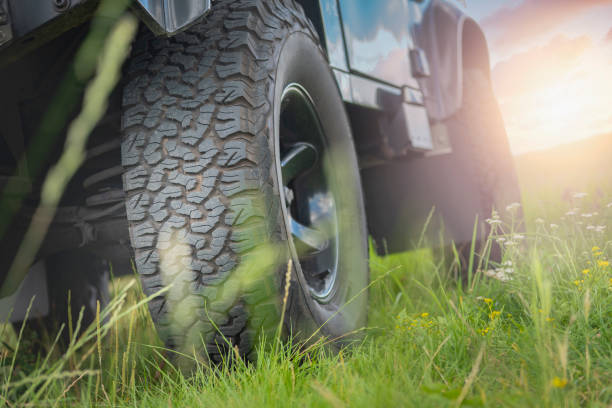
Car tire tread wear – How much is too much wear?
It is important not to drive on tires with too much tread wear as this reduces the traction you have on the road making it easier to slip, hydroplane and even pick up a puncture. Here are the minimum depths you need to stay safe:
- 6/32″ – tread depth is ok
- 5/32″ – start thinking of replacement – you could have trouble in wet weather
- 4/32″ – replace your tires as soon as possible
The best and most accurate way to measure your tread is with a proper gauge. They are easy to use, and you can find them at most gas stations or hardware stores. Find the shallowest groove on your tire and insert the pin on the gauge. read the scale and compare the results with the numbers above.
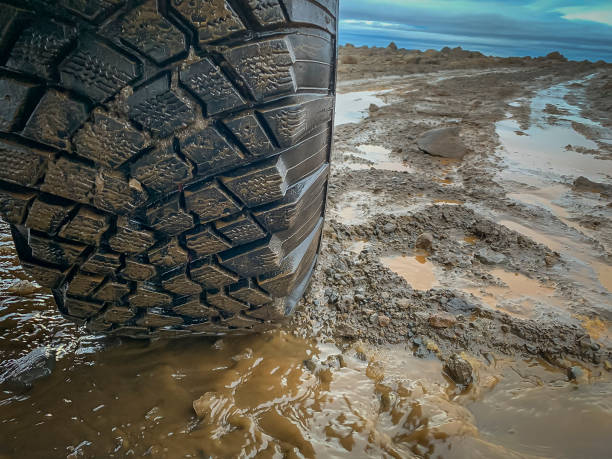
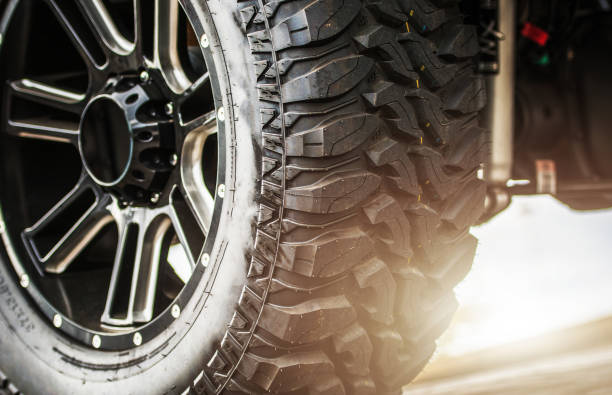
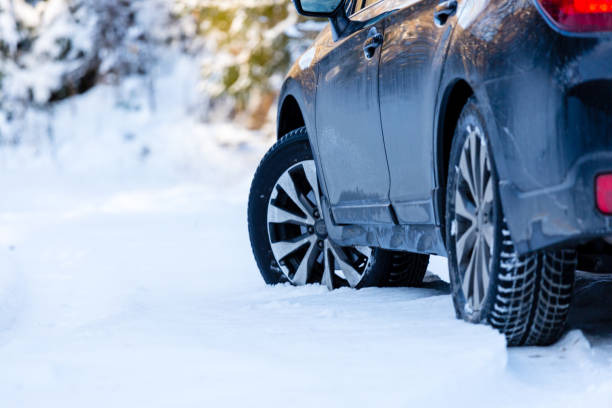
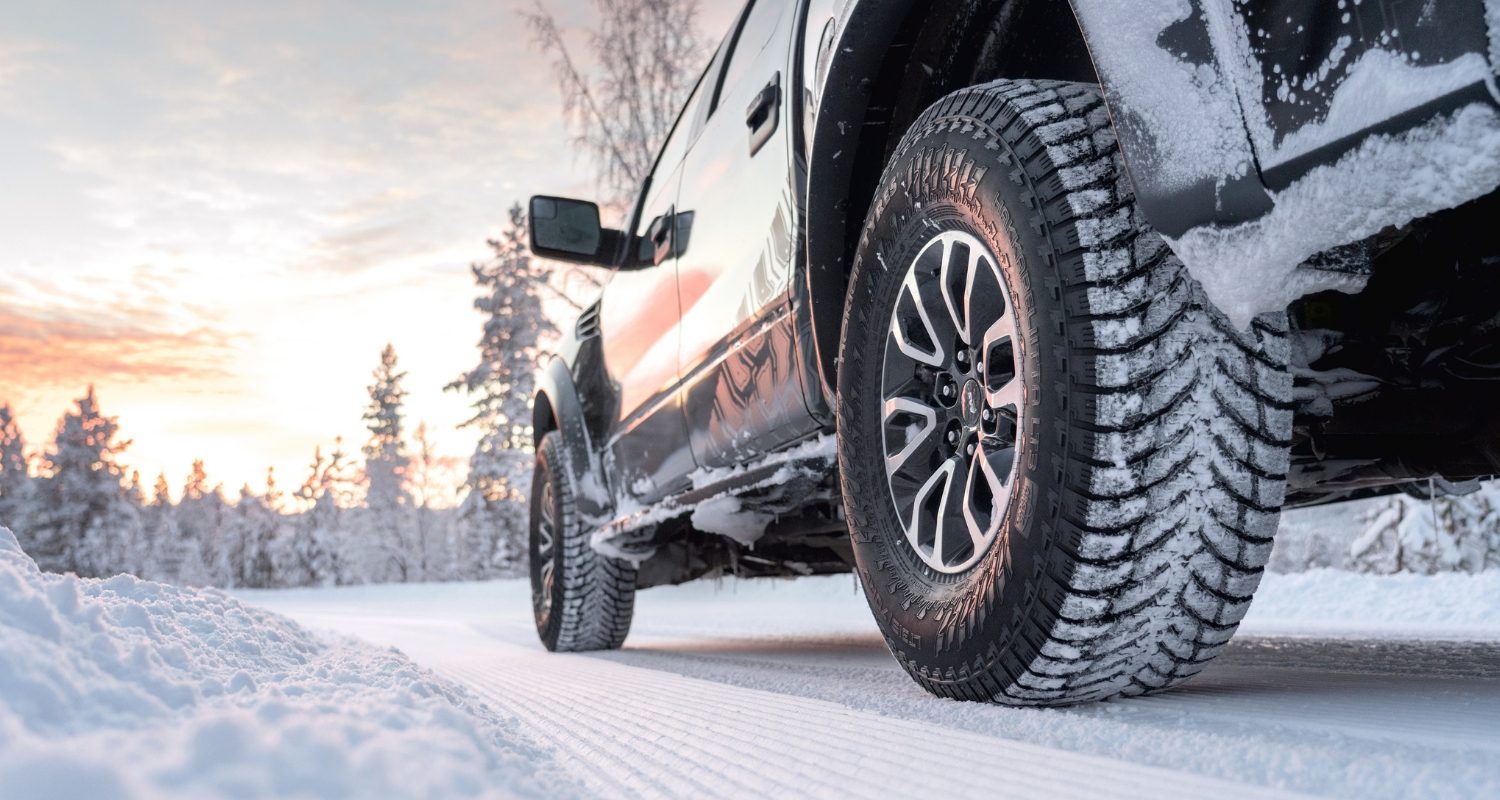
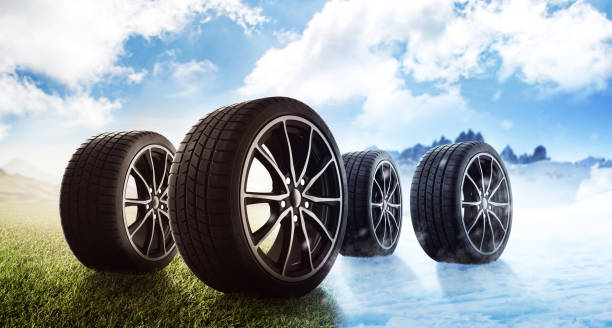
Canadian Auto/Napa Auto Care Centre Complete Automotive Service Repairs specializing in tires, wheel alignments, custom wheels, accessories, brake jobs, tune-ups, Lube / Oil / Filter services, Car key Replacement and Programming, mufflers, exhaust systems, electrical, automotive air conditioner repairs, automotive glass repairs and installation, mechanical, out of province inspections and much more. All work is repaired by licensed auto technicians.
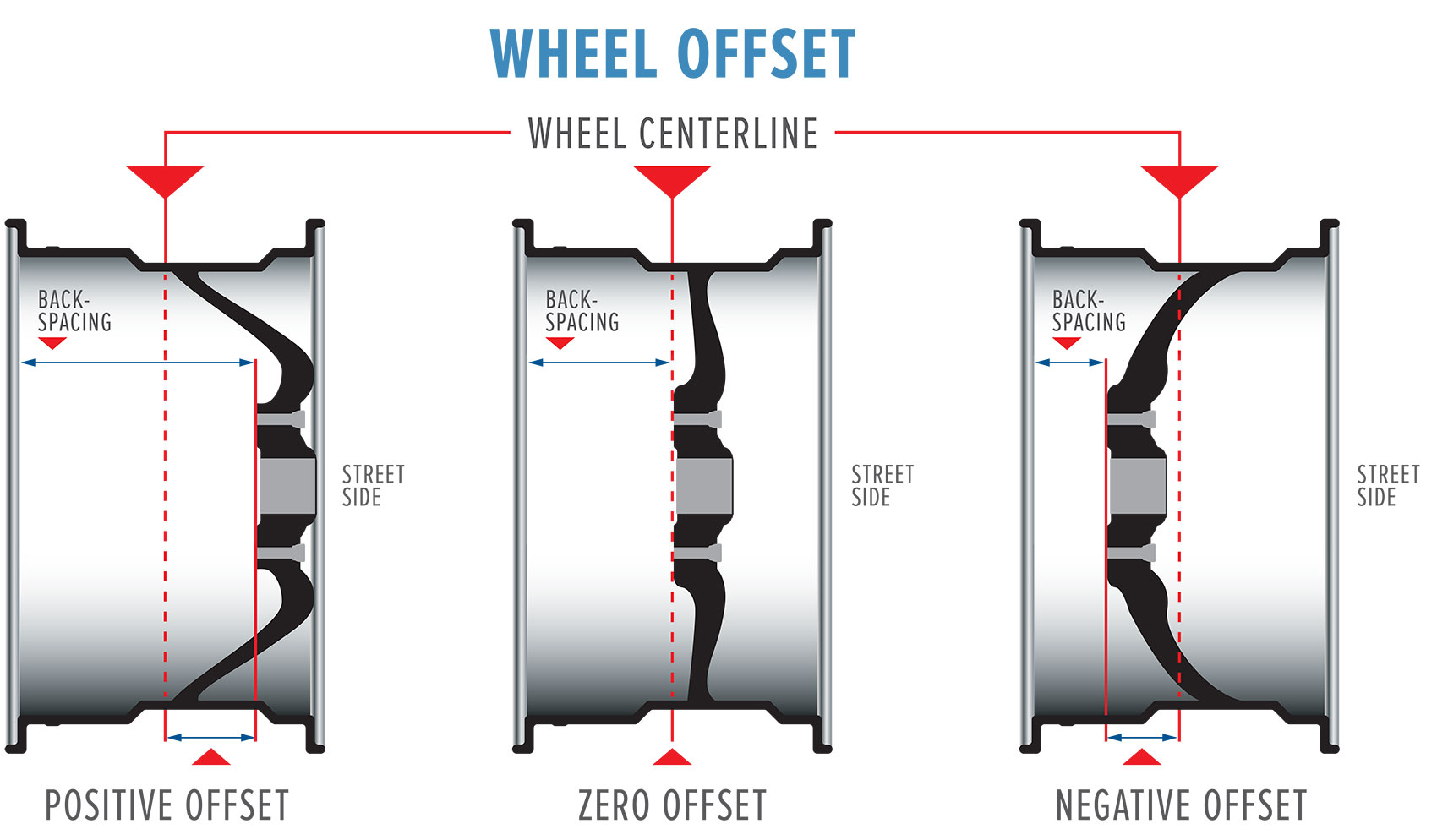
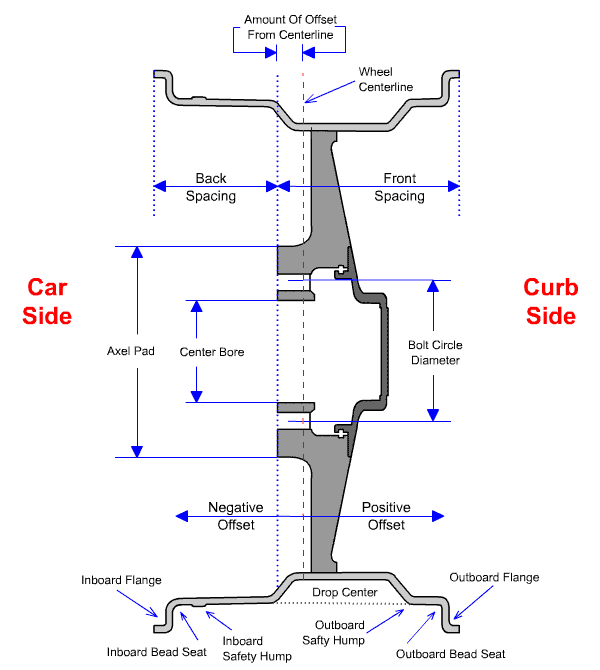
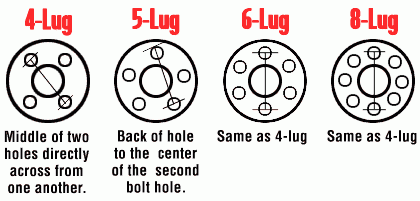
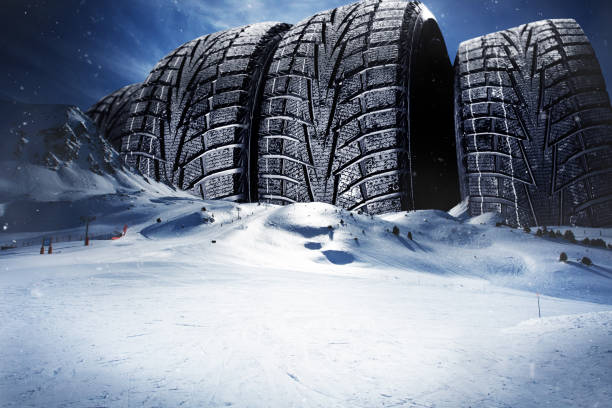
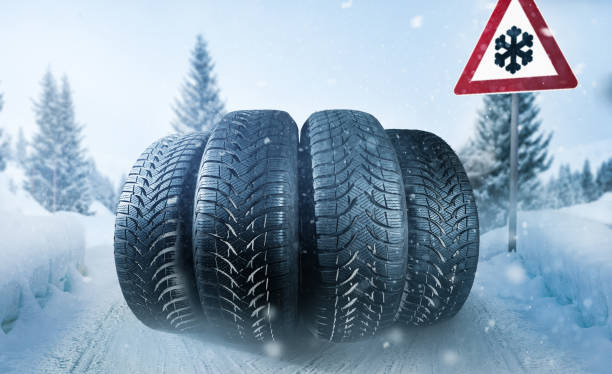
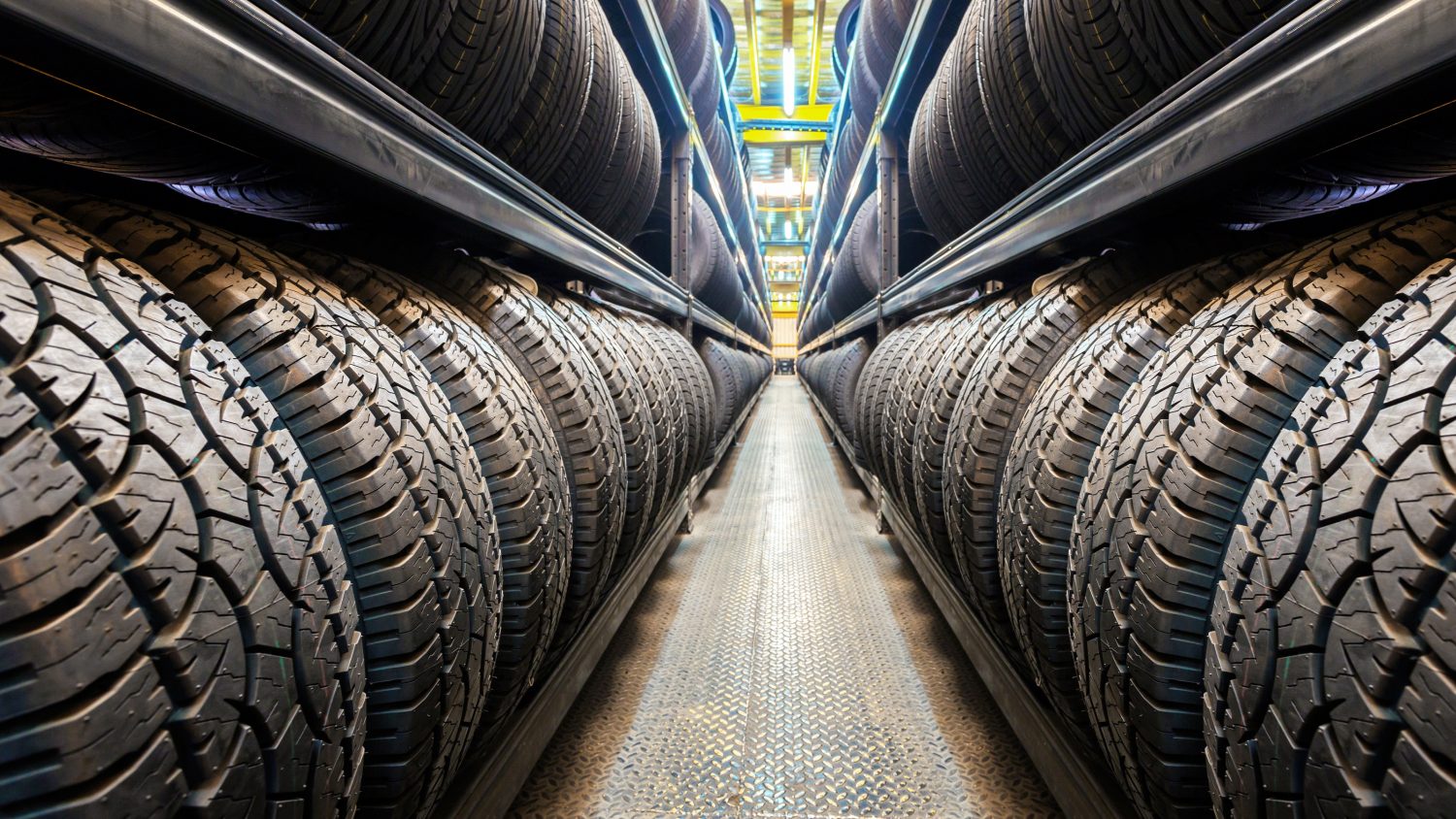
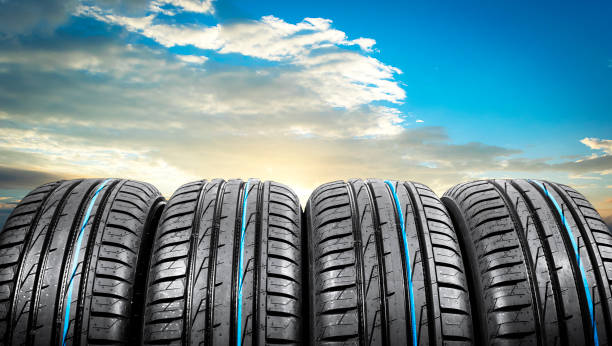
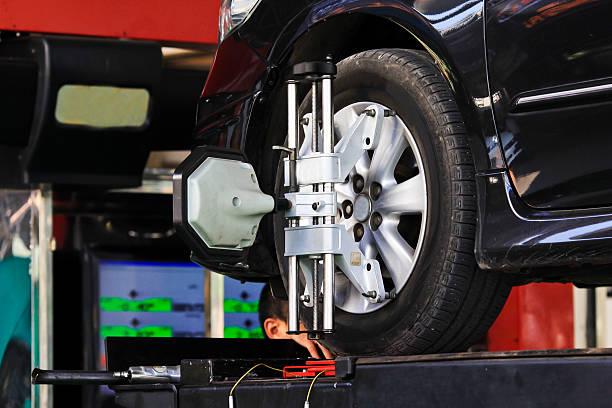
wheel alignments
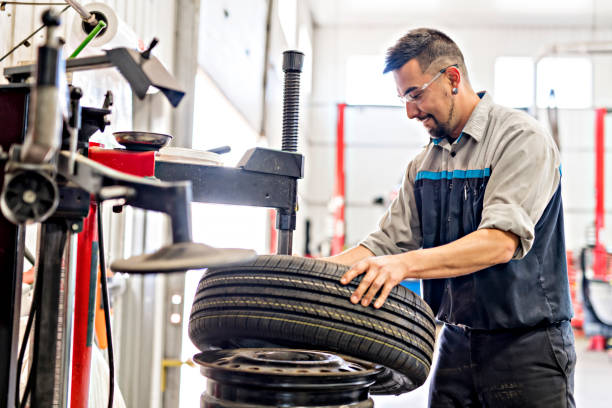
mount and balance
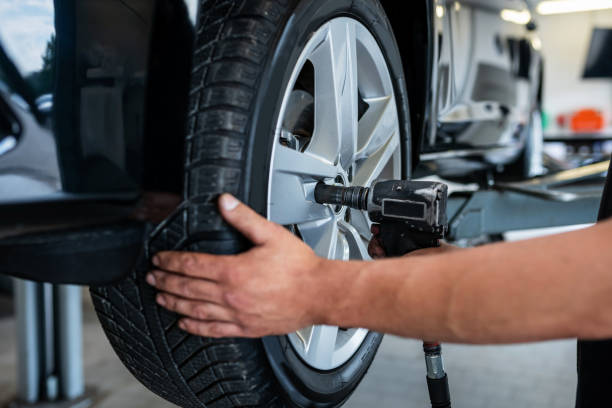
tire swap (Winter/summer)
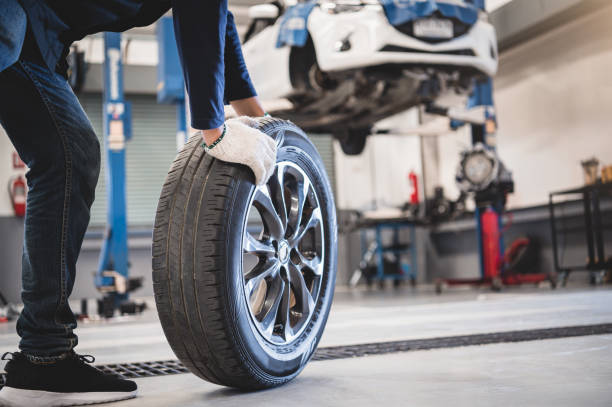
tire rotation
Determining What Size Tires, You Need
The correct tire for your vehicle will be a unique combination of different variables including the width, height, and diameter of the tire, as well as a combination the tire’s load capacity rating and speed ability. To find out what size tires you need and what speed/load rating your vehicle requires, check your owner’s manual. If the information is not listed there, it can usually be found inside the door jamb of the driver’s door, inside the glove box door, or inside the fuel tank hatch.
What Do the Numbers on The Sidewall Actually Mean?
Aspect ratio: The aspect ratio is essentially a measure of how tall your tire is. The larger the number, the taller the tire. The number is calculated by dividing the height of the tire by its width, then turning the result into a percentage. Your typical all-season passenger car tire will have an aspect ratio somewhere between 65 and 80.
Load index: Your tire’s load index lets you know how much weight the tire was designed to carry safely. By using the load index chart displayed below, you can match the rating up with the number of pounds the tire can support when it is inflated to its maximum air pressure. For example, if your load rating is 81, you can then determine that the tire was engineered to carry 1,019 pounds when fully inflated. Multiply this weight by four to find out the maximum carrying capacity for your vehicle. When buying aftermarket or replacement tires, it is important to find a model that matches the load index that was on the original equipment.
If you cannot find the information in any of these locations, read the information off of the sidewall on your existing tires. Here is an example of the types of numbers you want to look for:
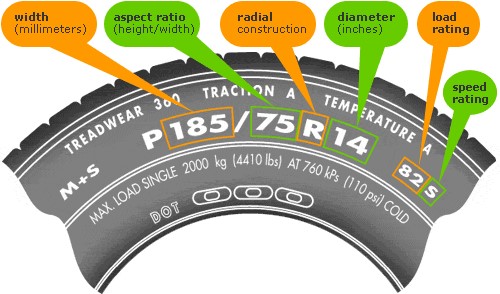
You can write all these numbers down and then bring them to Canadian Auto/Napa Auto Care Centre to see what tires are available in this size. That is all the information you will need to find tires that will fit your car as the manufacturer intended.
Speed rating: The speed rating is a number issued by the U.S. government which signifies how well a tire can reach and maintain a certain speed. Speed ratings are simply lettering which correspond to a specific top speed. Keep in mind that these are not recommended speeds to drive at, but simply a way to get a better idea of how well the tire will handle (tires with a hire speed rating are likely to provide better traction and handling). When buying new tires, always choose 4 tires with identical speed ratings. Mixing up the specifications on your tires will result in serious and unsafe driving conditions. It is also not recommended that you downgrade the speed rating on your tires. Always follow the manufacturer’s guidelines and buy tires with ratings that are identical to the original stock equipment.
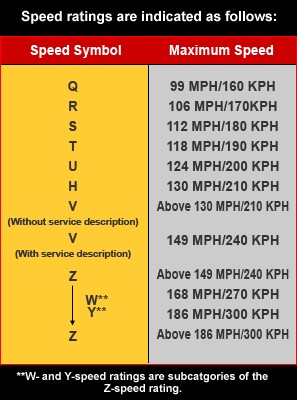
Once you have all the information from your tire sidewall or vehicle placard, you can now narrow down your search for new tires. Other variables like tread wear, traction, and temperature grades may affect the type of tires you need, but for everyday purposes the size, speed, and load numbers are all you will need. Contact Canadian Auto/Napa Auto Care Centre for more information about the different types of tires. We will assist you in finding the tires you want at the sizes you need.
SHOP POLICY IN EFFECT APPLICABLE TO ALL RETAIL AND FLEET SERVICE CUSTOMER.
All customers Please Read: Invoice Disclaimer / AMVIC License# B2008146 / GST# 82868 9471 RT0001
Customer agree and acknowledge that it shall be my responsibility to comply with the following below:
- After you install tires and wheels and you reach 100 to 150 kms of driving you are required to Re-Torque the wheels, just bring your car back to have your wheels re-torqued, no appointment required, and this is a free service hers and at all other shops.
- We are not responsible for any existing damage to mag or custom wheels when changing tires. If the lug nut was already cross threaded from a previous tire removal the lug might break off trying to remove the tire this time. More than likely, the lugs were over-torqued on prior occasions and the studs were already stretched.
- While working on your vehicle, sometimes certain parts might be difficult to remove and they might brake when we try to replace it due to excessive rust or they are completely seized, we can not be responsible or liable for replacing any part that brakes due to your vehicle condition at the time of vehicle being serviced.
- While the customer has the sole right to choose which parts are used for repairs to the listed vehicle, Canadian Auto Remarketing (car) Ltd reserves the right to exercise professional judgment and refuse to make repairs using parts which are deemed inadequate or unsafe.
- If additional parts or labor totaling over $100.00 are required, the customer will be contacted immediately for prior approval before the work is initiated.
- Customer can request that all old parts replaced be given back at the time that they picking-up their vehicle. After the vehicle is picked up all parts will be sent to the metal recycling yard for disposal and will not be available for return.
- If for some unforeseen reason within 30 days of the date that the work was performed, if the customer has issues with the work that was done, we will gladly check the work that we performed and make sure that it complies without any additional cost to the customer. No refunds can be made at any time on any service work performed after the customer picks-up the vehicle.
Canadian Auto Remarketing (car) Ltd shall not be responsible or liable for loss, damage due to fire, theft, accident, or other causes beyond Canadian Auto Remarketing (car) Ltd control, including impeding damage to the vehicle which may arise during the repair.
All personal information collected by Canadian Auto Remarketing (car) Ltd is protected under the Privacy Act of Alberta.
